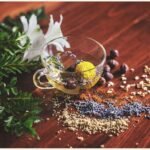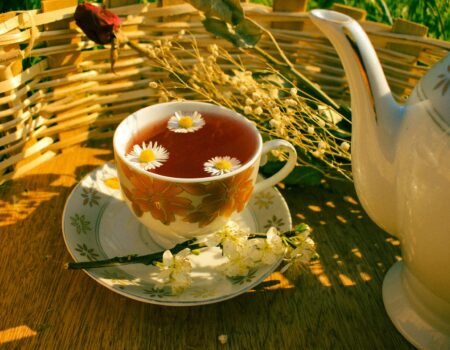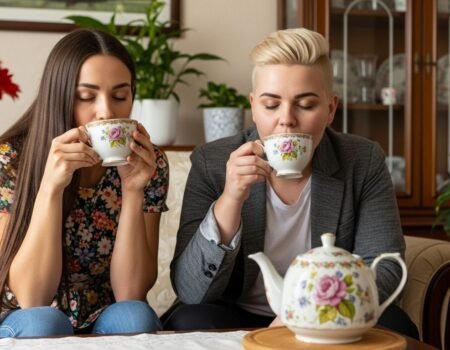Index
Index
The world’s most precious teas often grow in remote places, sometimes at elevations above 5,000 feet where unique climate conditions create distinct flavors.
This guide maps your journey through the elite world of rare teas from ancient Chinese treasures to Japanese premium varieties. You’ll learn what makes certain teas truly rare, how to spot authentic specimens, and proper brewing methods to extract their full character.
Key Takeaways
- True rare teas grow in specific places like Wu Yi Shan in China or high mountain regions of Taiwan, where unique soil and climate create flavors that can’t be copied elsewhere.
- Da Hong Pao, known as the “King of Oolong Teas,” once sold for $28,000 per 20 grams in 2002, making it one of the most expensive teas in the world.
- Elevation greatly affects tea quality. Teas grown above 4,000 feet develop more complex flavors because plants grow slower in cooler mountain air.
- Expert processing transforms ordinary leaves into treasures. Tea masters train for decades to perfect techniques like the precise oxidation control needed for premium oolongs.
- Japanese Gyokuro gets its unique sweet umami taste from being shaded 20-30 days before harvest, which increases chlorophyll and amino acids in the leaves.
Understanding Tea Rarity
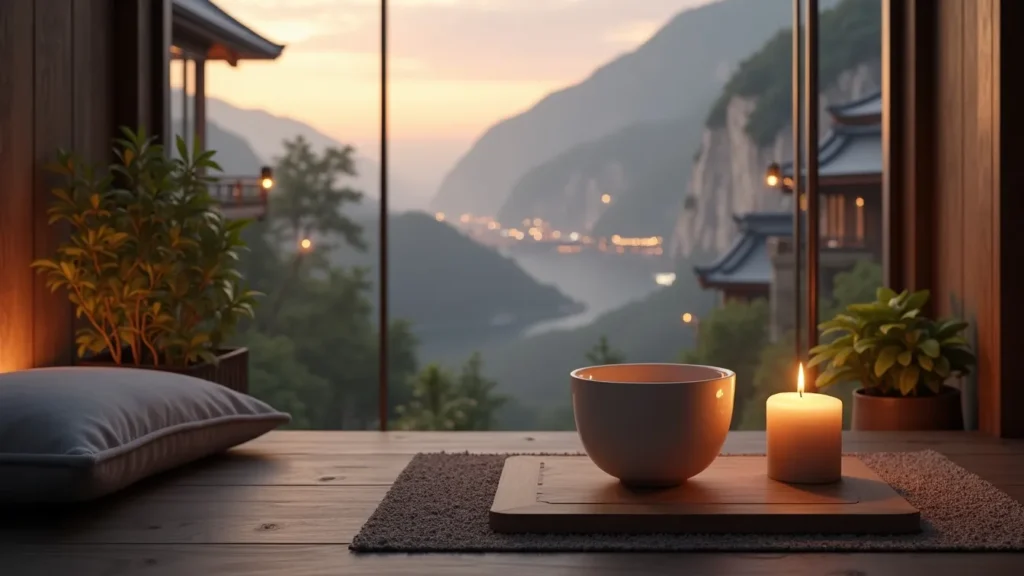
Rare teas stand apart from common varieties through special growing conditions, limited production, and unique processing methods. True tea rarity comes from specific mountain slopes, expert craftsmanship passed through generations, and sometimes centuries-old trees that produce distinct flavors.
What Defines a “Rare” Tea
Rare teas stand apart through limited production, special growing conditions, and unique processing methods. True rarities like Da Hong Pao from the Wuyi Mountains exist in such small amounts that a single gram can cost hundreds of dollars.
Many prized teas grow only at specific elevations, often above 4,000 feet where cooler temperatures and mist create perfect growing conditions. The “First Spring, First Pick” green teas like Longjing and Biluochun represent another level of exclusivity, harvested just once yearly during a brief window of perfect conditions.
The age of tea plants also marks true rarities in the tea world. Ancient tree teas from specific regions such as Lincang or Xishuangbanna in Yunnan come from plants that have grown for centuries.
Pu-erh tea, another category of rare Chinese tea, comes from these ancient trees in Yunnan Province. This unique tea undergoes either natural aging (sheng/raw pu-erh) or accelerated fermentation (shou/ripe pu-erh), developing complex earthy, woody, and sometimes sweet flavors over years or decades of proper storage.
These trees produce leaves with deeper flavors and more complex profiles than plantation bushes. Expert processing adds another layer of scarcity – skilled tea masters use techniques passed down through generations to craft teas with perfect oxidation levels and distinctive character.
This craft turns simple leaves into treasures that tea lovers seek globally.
The cultural and historical value of certain teas adds to their status as rare finds. Some varieties once served only imperial courts or were used in sacred ceremonies. These teas carry stories and traditions that make them more than just drinks.
The terroir – that special mix of soil, climate, and geography – shapes each rare tea’s unique profile and explains why certain regions produce teas of unparalleled quality.
The Role of Terroir and Growing Conditions
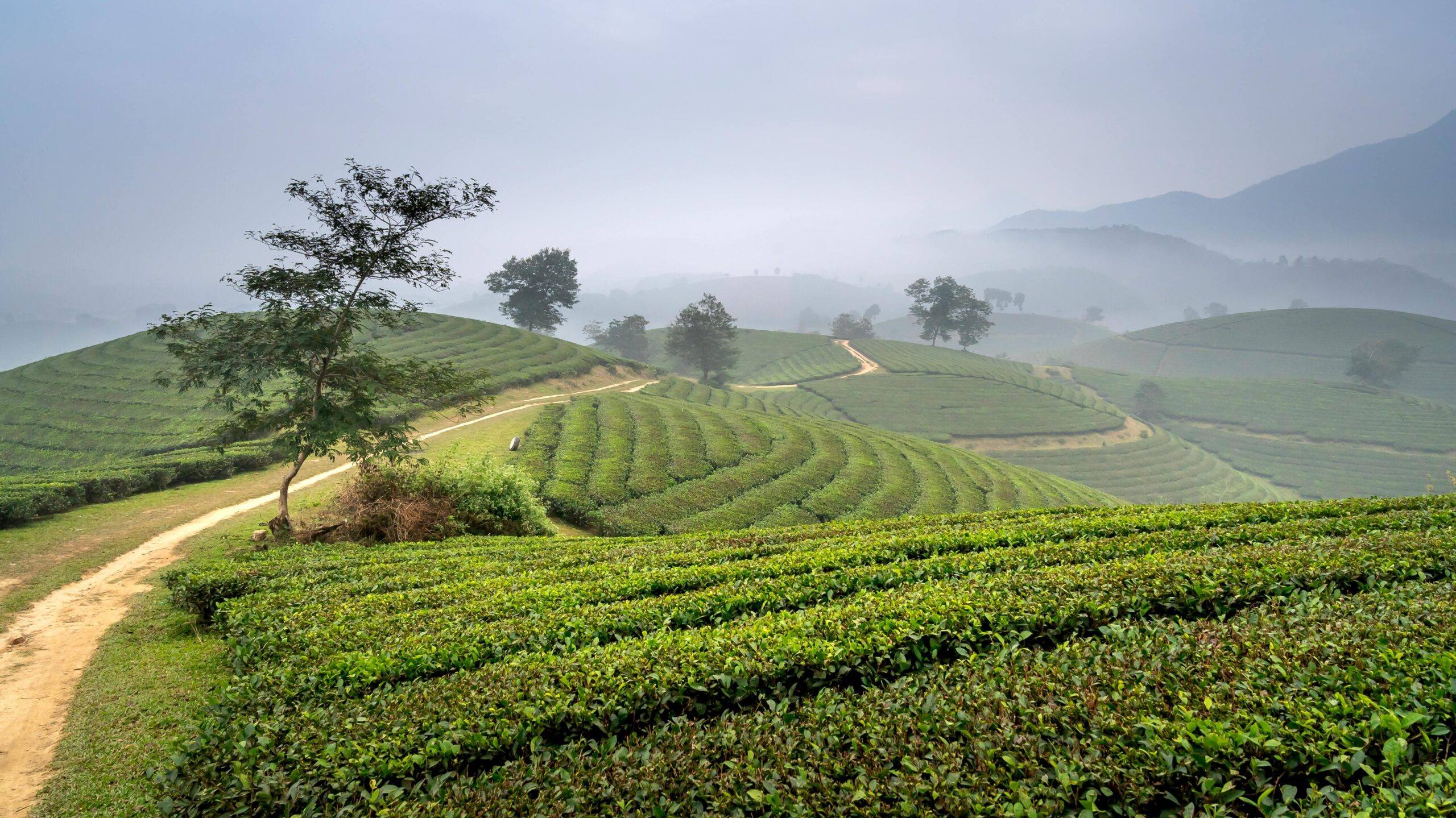
Terroir shapes tea quality much like it affects wine. The unique mix of soil, climate, and elevation creates distinct flavor profiles that can’t be copied elsewhere. In Wu Yi Shan, the rocky soil gives teas their famous “rock bone” flavor – a mineral taste that tea lovers prize.
The soil makeup, rainfall patterns, and daily temperature shifts all leave their mark on tea leaves, creating complex tastes that range from sweet to earthy.
Elevation plays a major role in rare tea production. Tea gardens sitting at higher feet above sea level often produce more nuanced flavors because plants grow slower in cooler mountain air.
The Zheng Yan area in Wu Yi Shan stands as a perfect example – this UNESCO World Heritage site creates teas with unmatched character. Tea farmers in these special regions follow cultivation methods passed down through generations, respecting the land that gives their product such value.
The finest leaves often come from gardens where nature and human expertise meet in perfect balance.
Impact of Processing Expertise
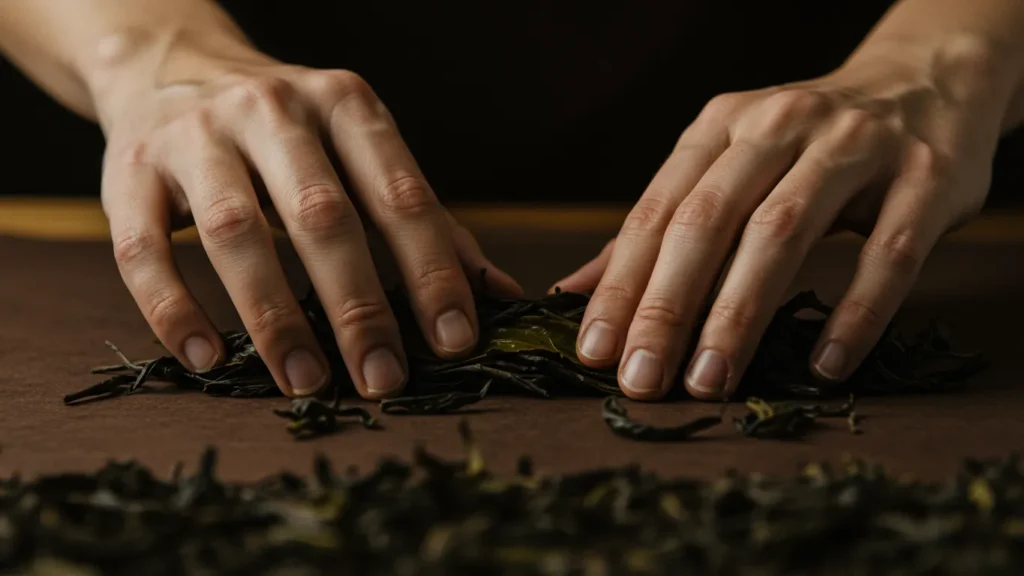
Processing expertise stands as the defining factor in rare tea creation. Tea masters with decades of experience know exactly when to pluck leaves, how long to wither them, and the precise roasting temperatures needed for perfect flavor development.
These skills transform ordinary leaves into treasures like Da Hong Pao, where traditional charcoal roasting over 2-3 stages spanning several months creates its signature mineral notes and “rock rhyme” character.
Tea processing remains both science and art – masters can isolate over 100 chemical compounds in oolong tea through their techniques alone.
Expert processing determines which teas can age gracefully for decades. White tea leaves require specific handling to develop their aging potential, while oolong processing demands exact oxidation control at multiple stages.
The difference between common tea and a $1,000 per ounce rarity often comes down to a tea master’s split-second decisions during critical processing moments. These techniques vary dramatically between regions, with each tea-growing area developing unique methods passed down through generations.
Historical and Cultural Significance
Rare teas hold deep roots in ancient traditions dating back to 2700 B.C. China, where Emperor Shen Nung first discovered tea by accident. Certain tea varieties were historically reserved for imperial courts and high officials, particularly during the Ming and Qing dynasties.
Tea became more than a drink—it transformed into an art form that sparked cultural exchanges across Asia and later with European nations, especially Britain. The British Empire’s tea trade changed global drinking habits and created new customs that blended Eastern and Western traditions.
Tea ceremonies showcase the cultural value placed on these rare leaves, with each region developing unique rituals to honor their finest varieties. Japanese tea masters perfect the art of serving gyokuro in specific cups, while Chinese connoisseurs use special clay pots for Da Hong Pao oolong.
These practices reflect a deep respect for both the beverage and the social bonds it creates. Geographic and growing conditions play crucial roles in creating rare tea varieties.
Categories of Rare Teas by Origin
Rare teas from different parts of the world offer unique flavors based on their distinct growing regions, with each area producing special varieties that reflect local soil, climate, and traditions – we will explore these treasures from China, Japan, Taiwan, and the Himalayas.
Imperial Chinese Treasures (Da Hong Pao, Jun Shan Yin Zhen)
Chinese imperial teas stand as the crown jewels in rare teas. These treasures combine centuries of tradition with growing conditions that cannot be replicated anywhere else on earth.
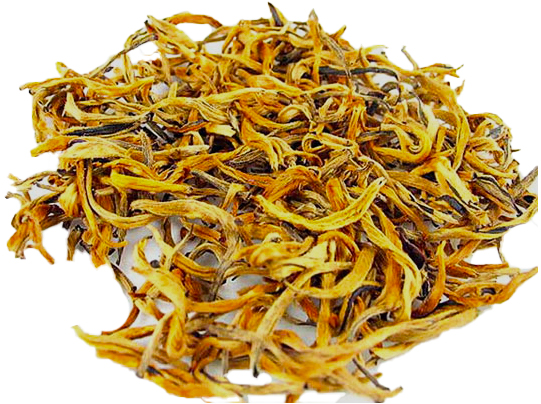
- Da Hong Pao, known as the “King of Oolong Teas,” grows on rocky cliffs in China’s Wuyi Mountains. The last harvest from the original Da Hong Pao trees sold for an astounding $28,000 per 20 grams in 2002, making it one of the most expensive teas ever sold.
- According to legend, Da Hong Pao cured a Ming Dynasty scholar (or in some versions, an emperor’s mother), who draped red robes over the tea bushes in gratitude. This story gave the tea its name, which translates to “Big Red Robe.”
- The flavor profile of Da Hong Pao offers complex notes of dark fruit, cocoa, and roasted grains. Each sip reveals new depths due to its partial oxidation process that brings out rich, layered tastes.
- The Fujian province produces some of China’s most prized tea varieties, including Bai Hao Yin Zhen (silver needle white tea).This region’s unique soil composition and climate create ideal growing conditions for premium tea.
- Imperial tea gardens often sit at high elevations where morning mist and cool temperatures slow leaf growth. This slow growth concentrates flavor compounds in the leaves and buds.
- Traditional processing methods for these teas remain largely unchanged for centuries. Tea masters undergo extensive training to master the hand-rolling, firing, and oxidation techniques required for premium teas.
Japanese premium varieties like Gyokuro represent another category of exceptional teas, with their own distinct cultivation methods and flavor profiles.
Japanese Premium Varieties (Gyokuro, Uji Gyokuro)
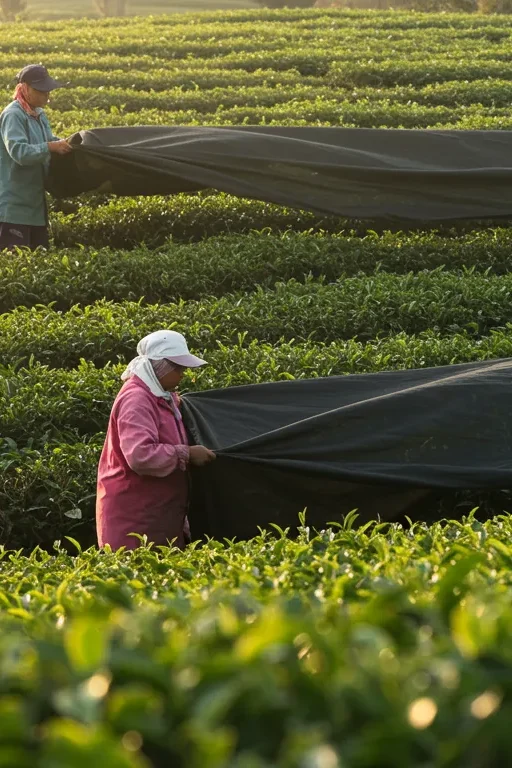
Japanese tea masters have perfected rare varieties that stand among the world’s finest teas. Gyokuro represents the pinnacle of Japanese tea craftsmanship, with methods passed down through generations.
- Gyokuro translates to “jade dew” in English, reflecting its bright green color and sweet flavor profile.
- Tea farmers shade these plants for approximately 20 days before harvest, which increases chlorophyll and amino acid content.
- The shading process boosts L-theanine content, creating the distinctive sweet umami taste that sets Gyokuro apart from other green teas.
- Uji Gyokuro comes from Kyoto Prefecture and holds the highest status among Japanese teas due to its perfect growing conditions.
- Tea experts consider Uji the birthplace of Japanese tea culture, with centuries of growing expertise.
- Farmers hand-harvest only the youngest, most tender leaves to create this premium variety.
- The traditional processing requires precise temperature control during steaming to lock in flavors.
- Brewing Gyokuro demands lower water temperatures (122-140°F/50-60°C) than most teas to extract its delicate essence.
- Quality gyokuro typically yields 3-4 infusions, with flavor profiles evolving with each steep.
- The finest Gyokuro leaves display a deep jade color with a silky texture that signals high quality.
- Tea competitions in Japan evaluate Gyokuro based on appearance, aroma, taste, and overall quality.
Taiwanese Special Grades (Da Yu Lin, Milk Oolong)

Moving from Japan’s shaded tea gardens, we now explore Taiwan’s mountain-grown treasures. Taiwan produces some of the world’s most sought-after oolong teas, prized for their unique flavors and limited availability.
Da Yu Ling grows at elevations exceeding 2,600 meters, making it one of the highest-grown teas globally. This extreme altitude creates stress on the tea plants, resulting in slower growth and more concentrated flavors.
The limited production of Da Yu Ling makes it highly valued among tea collectors and connoisseurs worldwide. Each harvest yields small batches that sell quickly to dedicated tea lovers.
High mountain air affects Da Yu Ling’s taste profile, creating notes of sweet orchid, butter, and subtle fruit undertones. The cool climate and frequent mist create ideal growing conditions for complex flavor development.
Milk Oolong (Jin Xuan) offers a naturally creamy texture and sweet milk-like taste without any additives. True Milk Oolong comes from the Jin Xuan cultivar #12, developed in the 1980s by Taiwan’s Tea Research Station.
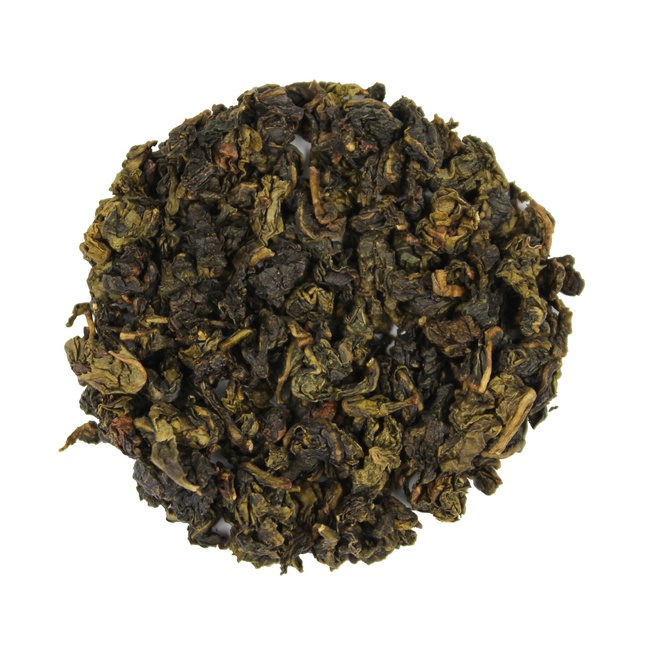
The unique milky characteristics come from specific processing methods and the natural plant compounds. Skilled tea masters control temperature changes during processing to enhance these creamy qualities.
Taiwanese tea farmers often use traditional hand-harvesting techniques to protect the delicate leaves. Only the freshest top leaves and buds make it into premium grades.
Spring and winter harvests typically produce the most flavorful teas due to optimal growing conditions. Many tea experts prefer spring harvests for their bright, floral qualities.
Storage affects these premium teas significantly, with proper airtight containers needed to maintain freshness. Exposure to air, light, or moisture can quickly degrade the subtle flavors.
Brewing temperature matters greatly for Taiwanese oolongs, with 185-195°F(85-90°C) water bringing out optimal taste. Multiple infusions reveal different flavor aspects with each steep.
Taiwanese tea culture blends Chinese traditions with local innovations to create unique tea experiences. Tea appreciation remains central to social gatherings and business meetings throughout Taiwan.
Himalayan Rarities (Silver Tips Imperial)
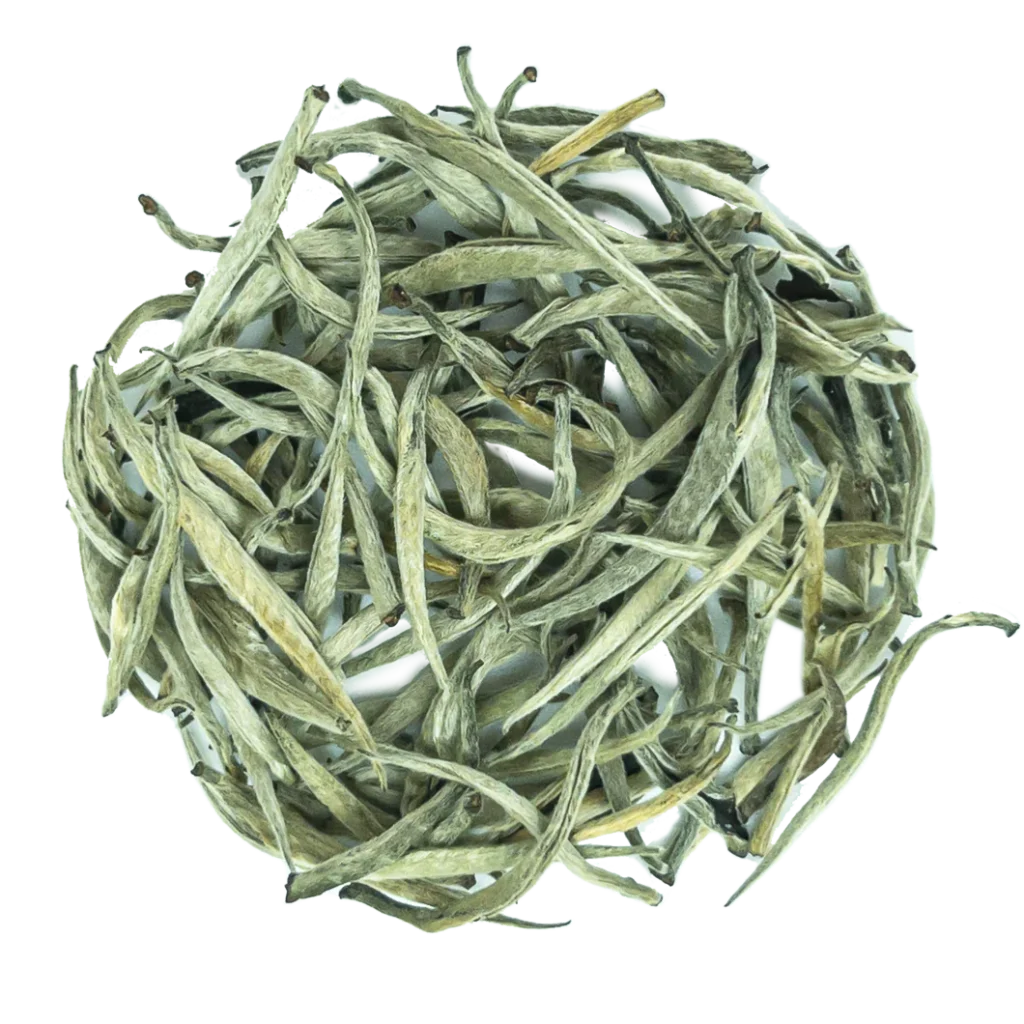
The Himalayas produce some of the world’s most sought-after teas. Silver Tips Imperial stands as the crown jewel of these high-altitude treasures.
- Silver Tips Imperial tea comes from Nepal’s misty mountains where spring harvests yield the finest crops.
- Skilled tea pickers select only the youngest buds before sunrise to preserve maximum flavor and nutrients.
- These rare teas grow at elevations above 4,000 feet where thin air and cool temperatures slow growth and intensify taste.
- Each silvery bud contains sweet, nutty notes that dance across your tongue with subtle floral hints.
- The caffeine content remains gentle at just 15-30 mg per cup, making it perfect for afternoon sipping.
- Harvest seasons last only a few weeks each year, creating natural scarcity that tea collectors prize.
- Local farmers use traditional methods passed down through generations to process these delicate leaves.
- The tea’s appearance features long, silvery buds that unfurl gracefully during brewing.
- Water temperature matters greatly – steep at 175°F (80°C) to extract optimal flavor without bitterness.
- Many tea experts recommend multiple infusions, as each steep reveals different flavor aspects.
- Limited production makes Silver Tips highly sought after by tea enthusiasts.
- Proper storage in airtight containers away from light preserves the delicate flavors for up to two years.
Next, we’ll explore aged and vintage teas that develop complex characters through careful maturation processes.
Geographical Exclusivity
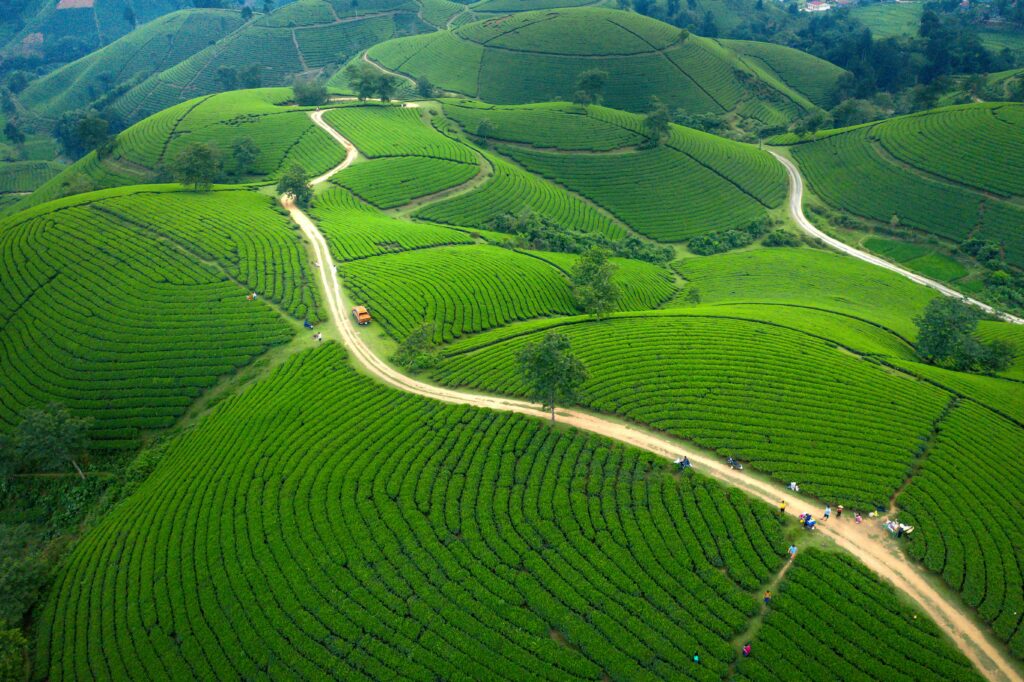
Tea’s finest qualities often come from specific places that cannot be duplicated elsewhere. Da Hong Pao oolong grows only on the rocky slopes of Wu Yi Shan in China’s Fujian Province.
The most prized leaves come from Zheng Yan, the central area where unique soil and climate create flavors that tea lovers search for worldwide. Tea from these exact spots commands higher prices because true terroir cannot be copied.
Mountain elevation plays a crucial role in rare tea production. High-altitude gardens in Taiwan’s misty peaks produce Da Yu Lin oolong with distinct sweetness. Japanese Uji Gyokuro thrives in its native region where shade-growing techniques have been mastered over centuries.
Each location stamps its signature on the leaves through unique mineral content, rainfall patterns, and daily temperature shifts that affect how flavors develop.
Rare teas reflect their birthplace in every sip. Silver Tips Imperial from the Himalayan foothills carries notes that speak of its mountain origins. Bai Ye region teas showcase flavors that cannot exist elsewhere due to their special growing conditions.
This geographical uniqueness creates a natural hierarchy of value among teas, with the most site-specific varieties becoming the most sought-after treasures for collectors and connoisseurs.
Elevation’s Impact on Flavor
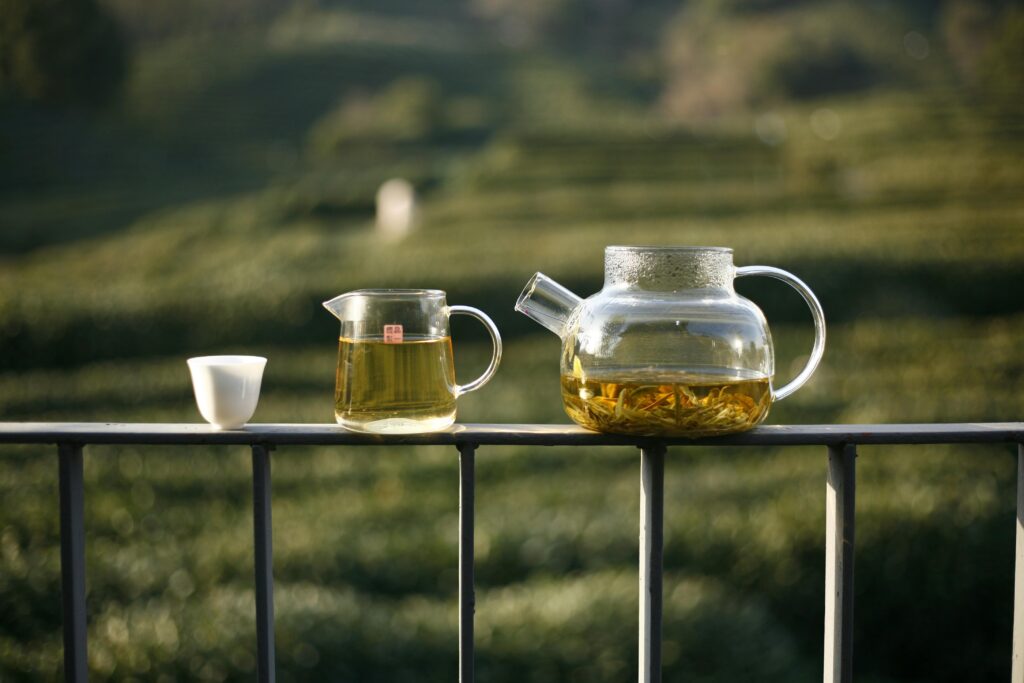
Teas grown at higher altitudes develop distinct flavor profiles that set them apart from their lowland cousins. Mountain-grown leaves mature slowly in cooler temperatures, which protects them from pests while concentrating their natural compounds.
This slow growth creates more complex tastes with less bitterness and adds subtle notes that tea lovers prize. High-elevation teas from places like Taiwan’s Da Yu Lin or Darjeeling’s upper gardens pack more flavor into each leaf.
Premium high-mountain teas maintain their strong flavors through five or more infusions, unlike lower-grown varieties that fade quickly.
Early spring harvests from these lofty gardens fetch top prices worldwide because the cold winter rest period boosts the plants’ natural sweetness.
Limited Production Masterpieces
Limited production teas stand as jewels in the tea world, crafted in tiny batches under perfect conditions. These rare gems often sell for hundreds or thousands of dollars per ounce due to their special growing locations and expert processing methods.
Da Hong Pao: The Big Red Robe Story
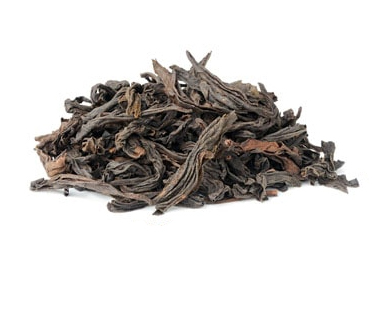
Da Hong Pao stands as one of the most treasured teas in the world, growing exclusively in China’s Wuyi Mountains. This rare oolong tea comes in three distinct types: Mother Tree, Purebred, and Blended varieties.
The Mother Tree Da Hong Pao ranks as the most expensive and sought-after version, with prices reaching thousands of dollars per ounce. Tea experts prize this variety for its rich flavor profile that combines sweet fruit notes with a distinct mineral taste from the rocky soil where it grows.
The legend behind this revered tea dates back centuries to the Ming Dynasty. Stories tell of a scholar who passed his imperial exams after drinking this tea, then draped his red robe over the tea bushes in gratitude.
True Da Hong Pao requires specific growing conditions and careful processing. Tea masters control each step with precision, from picking the perfect leaves to the intricate oxidation process.
For best results, brew Da Hong Pao with water around 195-205°F (90-96°C) for 30-60 seconds in the first infusion.The tea delivers multiple flavorful infusions, with each steep revealing new depth and character.
Yellow Tea: The Imperial Secret
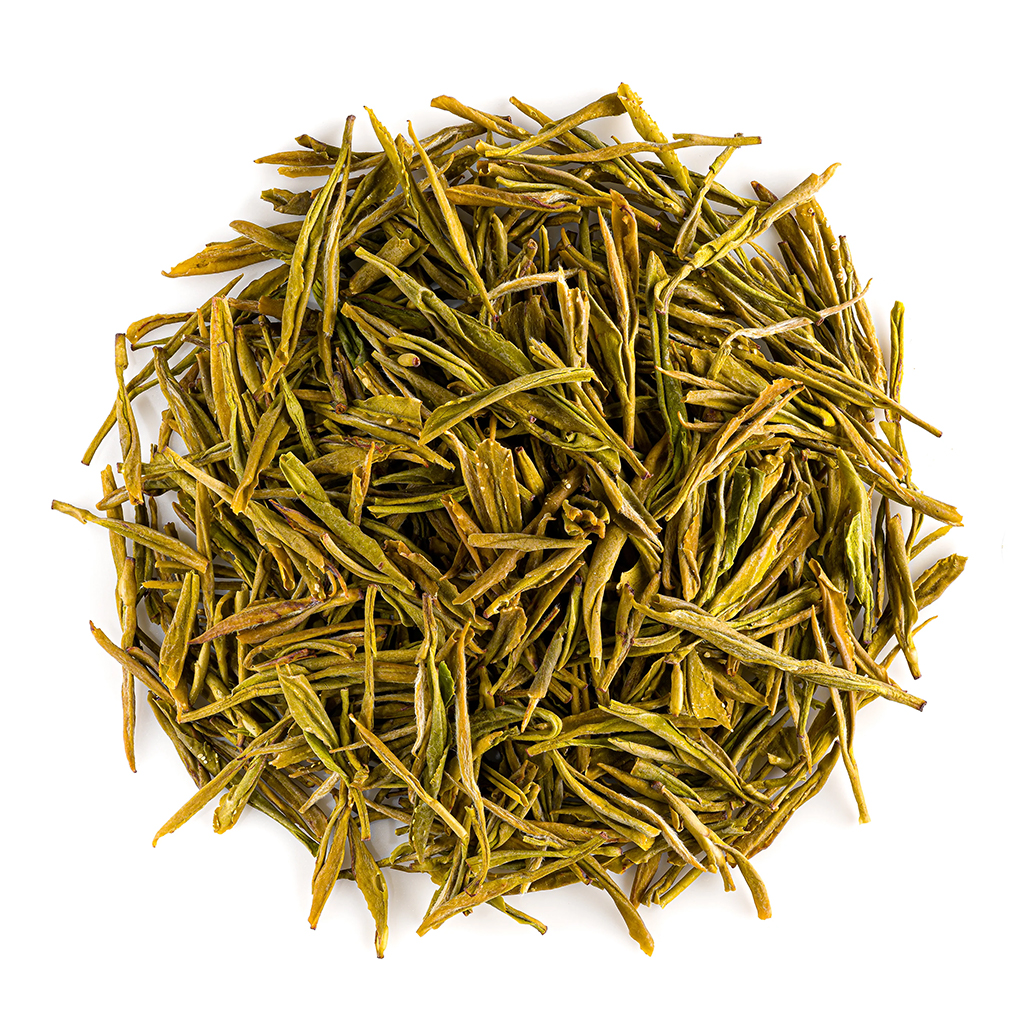
Yellow tea ranks among the world’s most rare and treasured teas, with roots dating back to China’s Tang dynasty. This exceptional brew gets its name from the unique “stuffing the yellow” step in processing, where tea leaves rest under a damp cloth.
This special method creates the signature amber color and gentle, sweet taste that sets yellow tea apart from its green tea cousins.
Jun Shan Silver Needle and Huo Shan Huang Ya stand as the most famous yellow teas today. These varieties once served as tribute teas for Chinese emperors, making them truly imperial drinks.
The limited production areas and complex processing make yellow tea hard to find outside China. Tea masters must control each step with great care to create the perfect balance of flavors that made this tea a favorite in royal courts.
Flavor profiles of quality yellow tea include mellow sweetness with none of the grassy notes found in green teas. The taste offers hints of chestnuts and dried fruits with a smooth finish that tea enthusiasts prize.
Each cup reflects centuries of Chinese tea culture and processing expertise.True yellow tea remains scarce in global markets, making each package a special find for serious collectors.
Jun Shan Yin Zhen: Single Island Yellow Tea
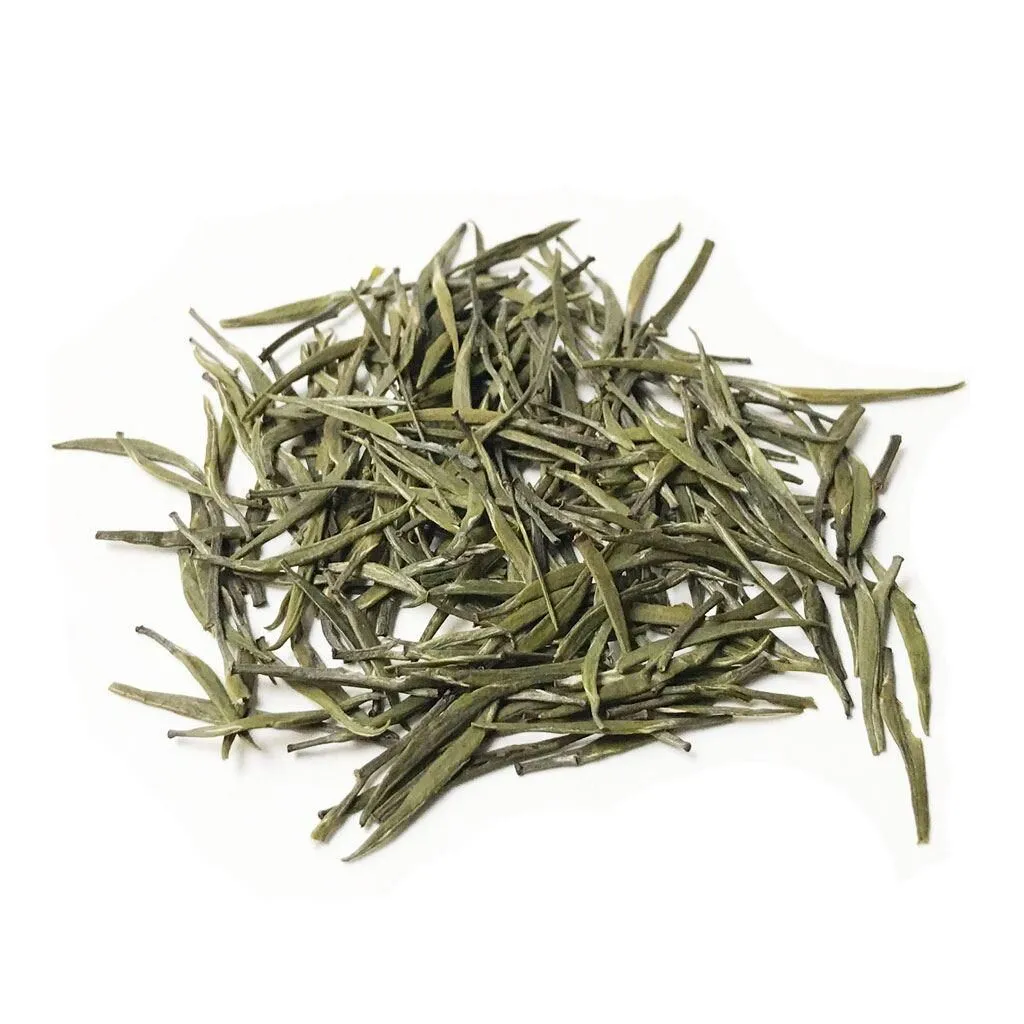
While imperial yellow teas remain shrouded in mystery, Jun Shan Yin Zhen stands as another treasure in the rare tea world. This rare yellow tea grows exclusively on Junshan Island in Hunan, China.
Tea experts prize it for its mellow sweetness, light floral notes, and smooth texture created through the unique “men huang” (sealing yellow) process.
The tea comes from mature plants, with each harvest collected from tea trees aged 15-20 years.
This hand-harvested delicacy delivers an unparalleled depth of flavor that reflects both its limited source and the dedication that goes into its production.
Uji Gyokuro: The Shaded Emperor

Moving from the rare Jun Shan Yin Zhen, we find another treasure in Japan’s Uji Gyokuro. This premium Japanese tea stands as royalty among rare teas, grown in the historic Uji district – Japan’s oldest gyokuro-producing region.
Tea farmers shade these plants for 20 days before harvest, which boosts both caffeine and amino acids. This careful process creates its signature sweet, umami flavor that tea experts prize worldwide.
Brewing Uji Gyokuro demands specific care to unlock its full potential. Use 1 tablespoon per 12 ounces of water at 140-160°F, then steep for 2-2.5 minutes.
Each cup delivers a smooth, rich taste that shows why this tea earned its nickname as the “Shaded Emperor” of the tea world. Its high-quality leaves can be infused multiple times, with each steep revealing new flavor notes.
Flavor Profiles of Rare Teas
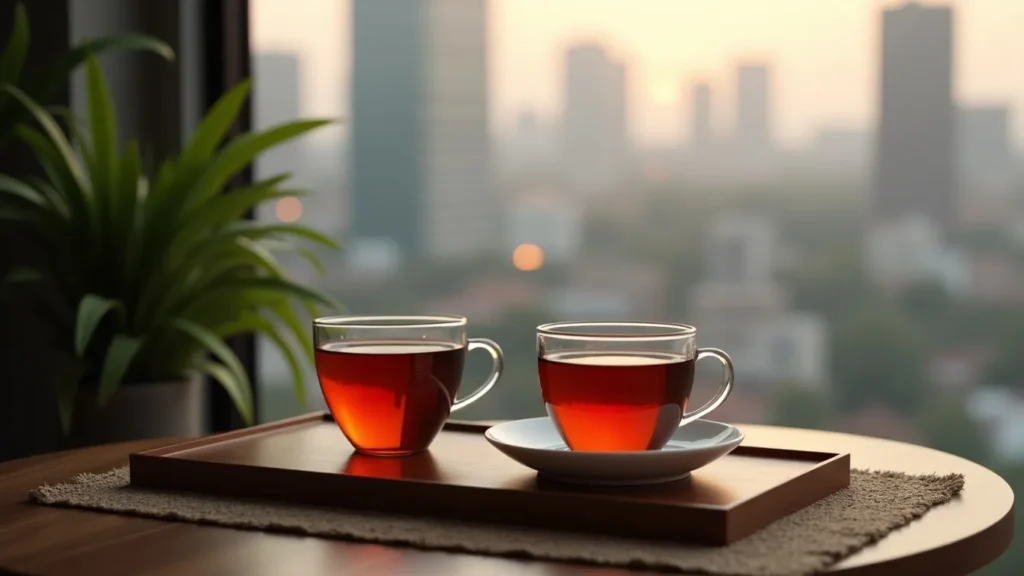
Rare teas showcase unique flavor profiles that set them apart from common varieties. Da Hong Pao offers a deep nutty caramel taste with distinct smokiness that lingers on the palate.
This Wuyi tea delivers complex layers that unfold with each sip, creating a rich experience tea collectors seek. The roasting process gives this tea its signature depth, making it one of the most sought-after varieties in the world.
Tieguanyin presents a complex flavor profile with pronounced floral notes that dance across the tongue. Its Iron Goddess character balances sweetness with subtle mineral undertones, while Milk Oolong surprises with its natural milky flavor and creamy texture without any additives.
Japanese Gyokuro stands apart with its intense umami flavor and thick mouthfeel, a direct result of the special shading techniques used before harvest. These premium teas deliver taste experiences that change dramatically between early and late steepings.
Aged and Vintage Teas
Aged teas transform over time into rare gems with complex flavors that new teas can’t match. These vintage treasures gain value through careful storage, which turns sharp notes into smooth, sweet profiles that tea experts prize.
Vintage Narcissus: The Preserved Orchid
Vintage Narcissus stands as a rare treasure in the tea world, prized for its deep fragrance and luxurious flavor profile. This exceptional oolong comes from tea trees over 60 years old, making it highly sought after by serious collectors.
The leaves undergo a multi-stage aging process that creates its complex taste notes – similar to how fine wine develops character over time.
Tea masters harvest only select leaves for this special variety, which represents just 1% of Japan’s total tea production since the Edo era. Each sip offers layers of flavor that unfold gradually, revealing subtle orchid-like notes that give this tea its poetic name.
Many tea experts consider Vintage Narcissus the perfect introduction to aged teas because it balances traditional processing with remarkable taste complexity.
Aged White Peony: The Mellowed Classic
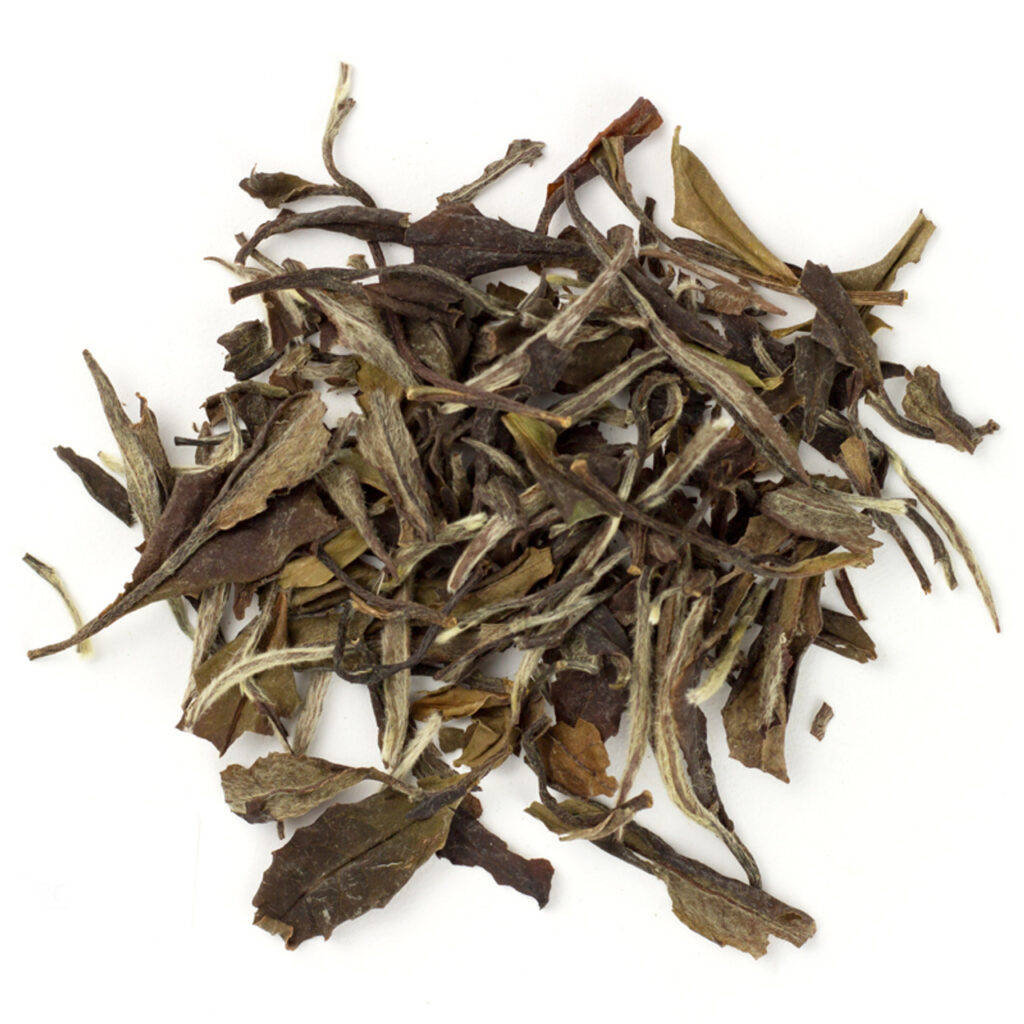
Aged White Peony tea transforms into a mellow masterpiece through time, gaining depth that young versions simply cannot match.
Tea experts prize its rich complexity that builds with each steeping – you can brew it at least five times to unlock its full character. The aging process turns the bright, floral notes of fresh White Peony into deeper honey and dried fruit flavors.
Properly aged teas develop unique qualities over time that differ significantly from fresh versions. Unlike black tea that peaks quickly, White Peony gains value over years as its flavor profile expands.
The aging process creates notably different flavor profiles compared to fresh white tea.
Aged Tieguanyin: The Ancient Iron Goddess
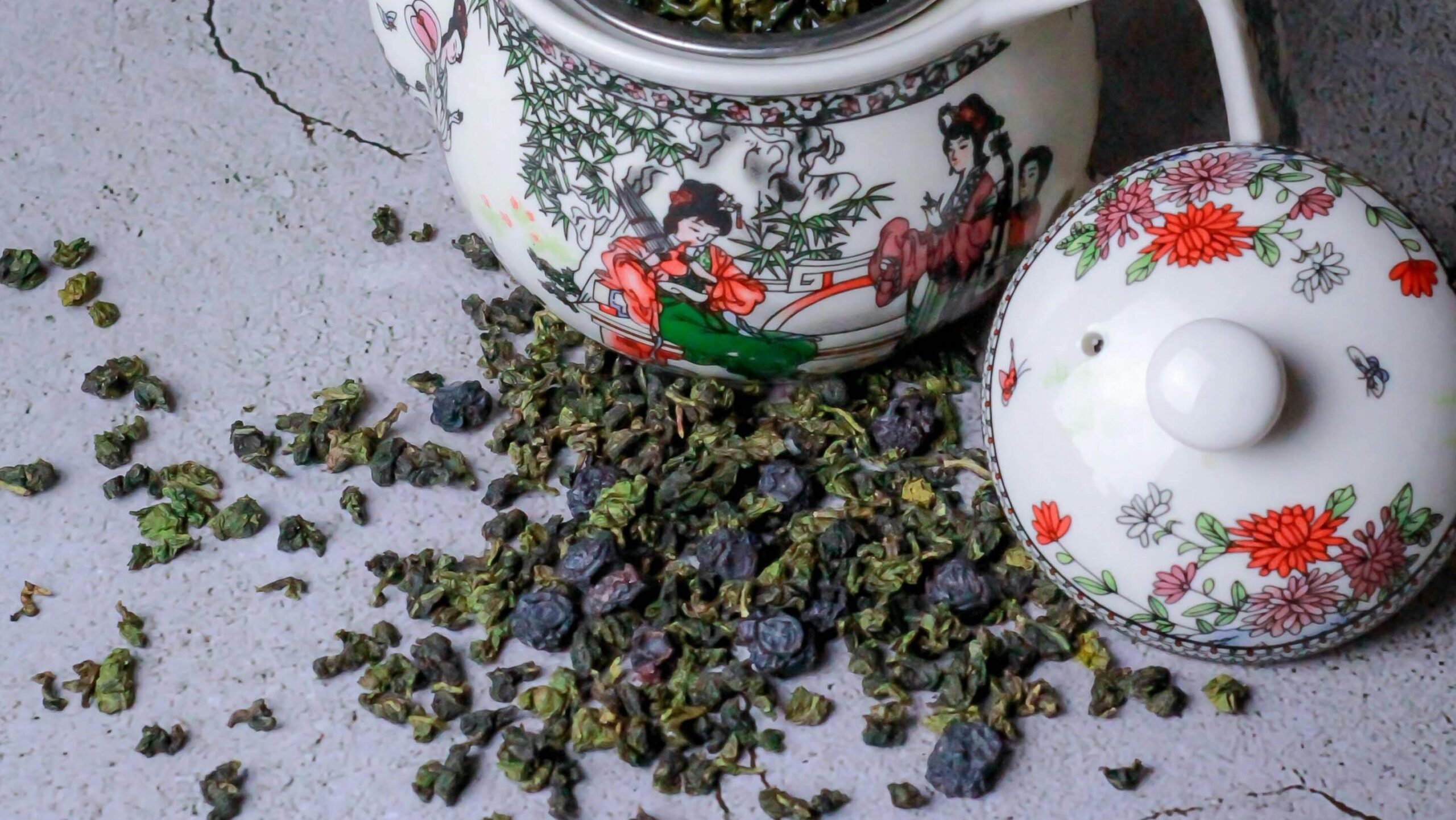
Tieguanyin, known as the “Iron Goddess of Mercy,” transforms into a remarkable treasure through careful aging. This oolong tea develops unique tasting notes over time, with hints of dried fruit, roasted nuts, and honey emerging as it matures.
The Rare Tea Company offers select aged versions that showcase these complex flavors. Tea masters store these leaves in special clay containers that allow the tea to breathe while protecting it from light and moisture.
Traditional infusion methods bring out the best in aged Tieguanyin. Most experts suggest using water around 195°F (90°C) with brief initial steeps of 30-45 seconds. Each subsequent steep can last slightly longer, often yielding 5-7 flavorful cups from a single serving.
The aging process softens the original floral notes while adding depth and richness to the cup. Many tea lovers prize these aged versions for their smooth texture and lack of astringency compared to their younger counterparts.
Proper Storage Methods
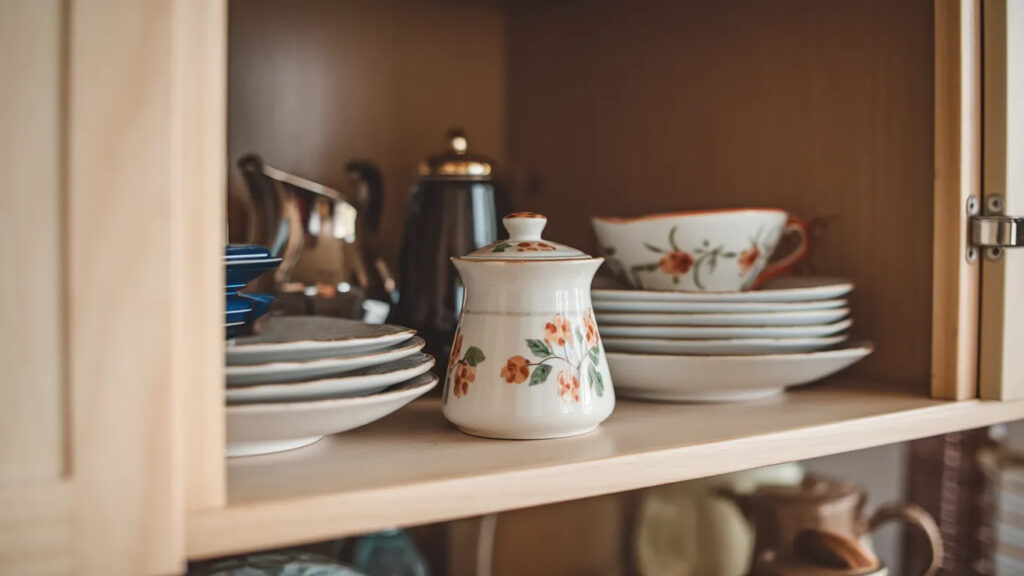
While Aged Tieguanyin transforms over time into a complex, mellow brew, its quality depends greatly on proper storage. Keeping your rare teas in ideal conditions preserves their distinct flavors and extends their lifespan significantly.
- Store all premium teas in cool, dark places away from direct sunlight which can degrade flavors quickly.
- Keep rare teas away from strong odors as tea leaves absorb ambient scents easily, affecting their natural profiles.
- Maintain a dry environment for your tea collection since moisture leads to mold growth and flavor loss.
- Use airtight containers made of metal, glazed ceramic, or high-quality plastic to limit oxygen exposure that causes oxidation.
- Label each container with purchase date and tea type to track aging progress and optimal drinking windows.
- Avoid storing different tea varieties together as flavors can transfer between leaves.
- Green teas typically maintain peak quality for 6-12 months when stored properly.
- Black and oolong teas can maintain quality for 2-3 years, while some white teas and pu-erh can improve with age under proper storage conditions.
- Traditional Japanese tea storage often involves specialized ceramic jars that regulate humidity naturally.
- Refrigeration works for short-term storage of some green teas but requires careful handling to prevent condensation when removed.
- Freeze particularly valuable teas only if they’re completely sealed against moisture and brought to room temperature before opening.
- Aged teas benefit from consistent storage conditions with minimal temperature and humidity fluctuations.
- Check stored teas periodically for signs of moisture damage or pest activity.
- Rotate your collection based on optimal drinking windows, enjoying each rare tea at its peak flavor point.
Evaluating Aged Characteristics
Aged teas develop unique traits through natural fermentation that fresh teas lack. Aged ripe (shou) pu-erh offers a perfect example – a 14-year-old specimen displays deep, woody notes and smooth mouthfeel that replace the sharp edges found in younger versions.
Tea experts look for specific markers in aged varieties: darker liquor color, reduced astringency, and complex flavor layers that might include notes of dried fruit, wood, earth, or mushrooms.
These traits signal proper aging rather than simple staleness.
Tasting aged tea requires attention to both aroma and taste changes across multiple steepings. Raw pu-erh differs greatly from ripe pu-erh due to the “wo dui” fermentation process, creating distinct aging paths.
Aged white tea often shows honey-like sweetness, while dark teas develop rich mineral qualities. The tea’s storage history plays a crucial role too—proper humidity and temperature create desirable traits, while poor storage leads to flat or musty flavors that signal poor quality.
Artisanal Processing Methods
Artisanal tea processing demands skills passed down through generations of master craftsmen. Each step – from hand-plucking to specialized roasting – creates teas with deeper flavors than machine-processed varieties.
Traditional Hand Processing
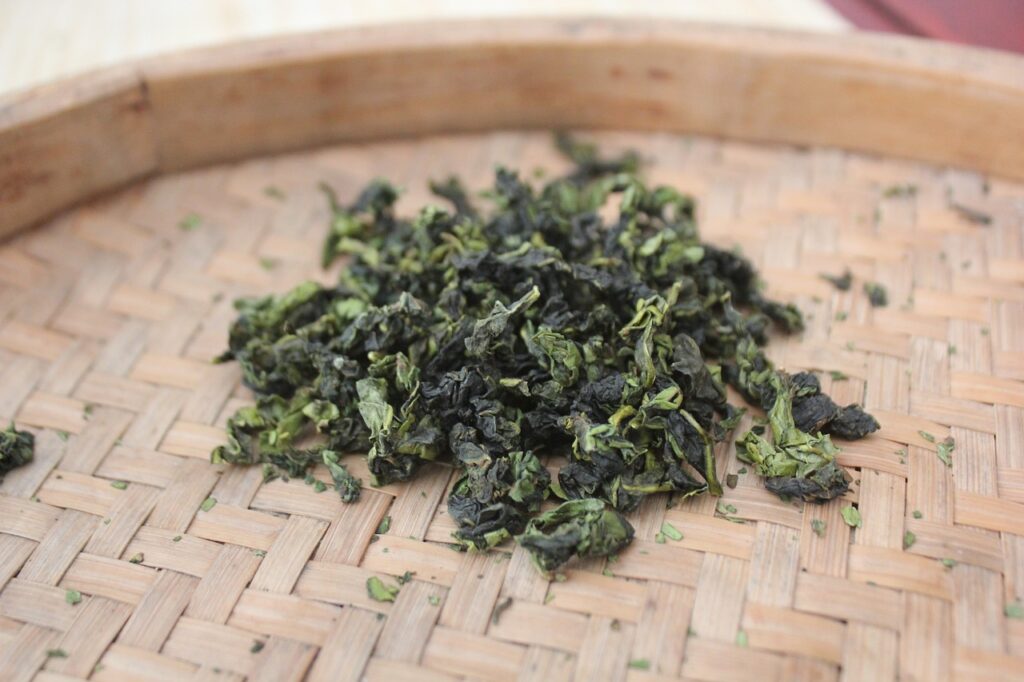
Traditional hand processing creates the world’s finest teas through methods passed down for centuries. Expert tea artisans pluck each leaf with care, selecting only tender leaves and unopened buds that contain the richest flavors.
This careful selection makes rare teas like Da Hong Pao and Silver Tips Imperial stand out from machine-harvested varieties. The human touch allows for precise judgment about leaf maturity and quality that machines simply cannot match.
Hand processing supports both quality and community. Local workers gain steady jobs through these labor-intensive methods, preserving cultural traditions while supporting regional economies.
The manual techniques used for premium teas like Gyokuro and aged Tieguanyin require deep knowledge that takes years to master. Each step—from withering to rolling to firing—demands specific skills that affect the final cup’s taste profile.
Tea masters can detect subtle changes during processing and adjust their techniques to bring out the best flavors.
Specialized Shading Techniques

Beyond hand processing, tea masters employ specialized shading methods that transform flavor profiles. Farmers place bamboo mats or black cloth over tea plants to limit sunlight exposure during growth.
This technique boosts amino acids while reducing tannins, creating teas with sweeter, more complex tastes.
Japanese Gyokuro is the prime example of shading mastery. Farmers cover these premium tea plants for 20-30 days before harvest, which dramatically changes their chemical makeup. The limited sunlight forces the leaves to produce more caffeine and L-theanine amino acids.
These compounds give Gyokuro its signature umami flavor and smooth texture that tea lovers prize worldwide.
Shading techniques vary by region and tea type. Some producers use gradual shading schedules, while others adjust coverage density based on weather patterns. The exact timing, materials, and methods remain closely guarded secrets among tea families.
This careful light manipulation represents one of the most precise steps in crafting rare, high-demand teas that command top prices in the global market.
Complex Oxidation Controls
Tea masters control oxidation with precise timing and environmental factors to create distinct tea varieties. This critical process transforms fresh leaves into green, oolong, or black tea through careful exposure to oxygen.
Master producers adjust humidity, temperature, and air circulation during processing to achieve specific flavor profiles. They monitor leaf color changes from green to copper-red, stopping oxidation at exactly the right moment through heating methods like pan-firing or steaming.
The finest rare teas often require multiple oxidation stages with rest periods between them. This complex approach creates deeper flavors and unique aromatic compounds not found in mass-produced teas.
For example, Da Hong Pao undergoes partial oxidation with several pauses, developing its signature roasted fruit notes and honey-like sweetness. Next, we’ll explore how multi-stage roasting further enhances these premium teas.
Multi-Stage Roasting
Multi-stage roasting stands as a hallmark of premium tea production, especially for Wuyi rock teas. Master craftsmen apply heat to tea leaves at different temperatures and durations, creating layers of flavor impossible to achieve through single roasting.
Each stage builds unique characteristics – the first develops base notes, middle stages add complexity, and final roasts lock in distinctive aromas.
Traditional methods remain vital despite modern equipment. Tea producers often roast leaves over charcoal fires, monitoring each batch with practiced eyes rather than timers. This careful process transforms raw leaves into complex brews with notes ranging from fruity to caramel-like.
Proper multi-stage roasting balances the tea’s natural qualities while adding depth that tea enthusiasts worldwide seek in rare varieties.
Modern Premium Innovations
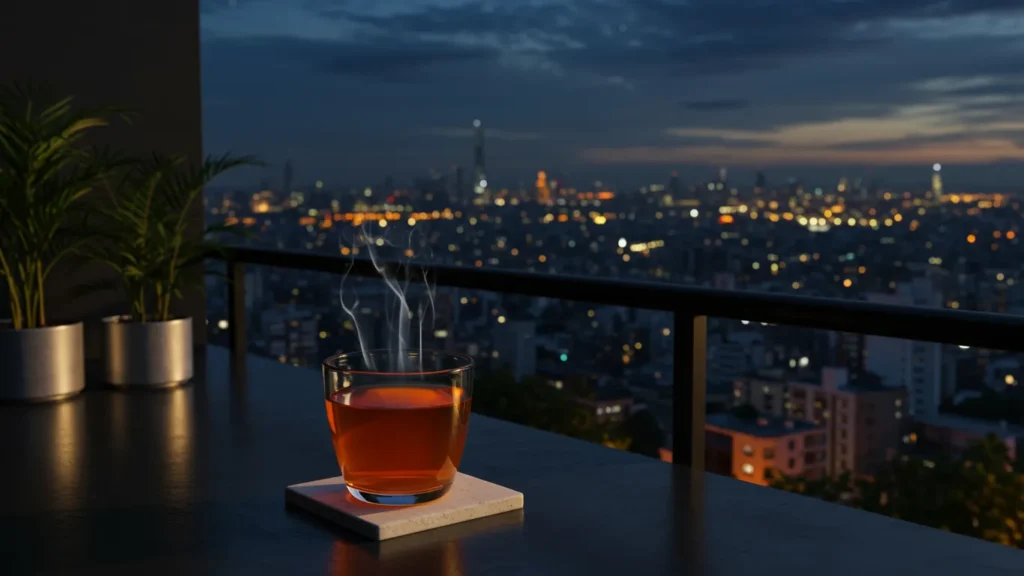
Tea makers now blend science with craft to create new flavors and styles that push the limits of what tea can be – read on to see how these fresh methods are changing the tea world.
Contemporary Craft and Experimental Methods
Tea artisans now push boundaries with fresh processing methods that transform flavor profiles. Small-batch producers experiment with custom oxidation levels, creating unique taste signatures not found in traditional teas.
These innovations include flash-freezing tea leaves, controlled fermentation with specific bacteria strains, and smoke infusion using rare woods like cherry or apple.
Modern technology enhances these craft approaches through precise humidity control and temperature monitoring. Japanese tea masters employ computer-guided roasting that adjusts heat based on leaf moisture content, while Taiwanese producers use vacuum-sealing to create pressure-influenced oolongs.
The marriage of ancient wisdom with new techniques delivers teas with complex notes that appeal to both purists and adventurous drinkers alike.
Emerging Regions
Tea regions beyond traditional powerhouses now produce remarkable varieties worth attention. Countries like Malawi, Kenya, and Thailand craft unique teas that challenge classic producers.
These newcomers benefit from global warming’s shift in growing zones, allowing them to develop distinctive flavor profiles not found elsewhere.
Global tea production continues to expand as farmers apply ancient methods to new terrains. Many of these regions grow organic tea at high elevations, creating bold flavors that satisfy demanding tea drinkers.
Small farms in Vietnam, Georgia, and Nepal deliver straight to customers through subscription services, making rare teas more accessible than ever before.
Understanding Quality & Brewing
Learning to spot quality tea and master brewing methods opens a world of flavor that most tea drinkers miss – discover the exact water temperatures, special tools, and tasting techniques that will transform your rare tea experience.
Developing Your Palate
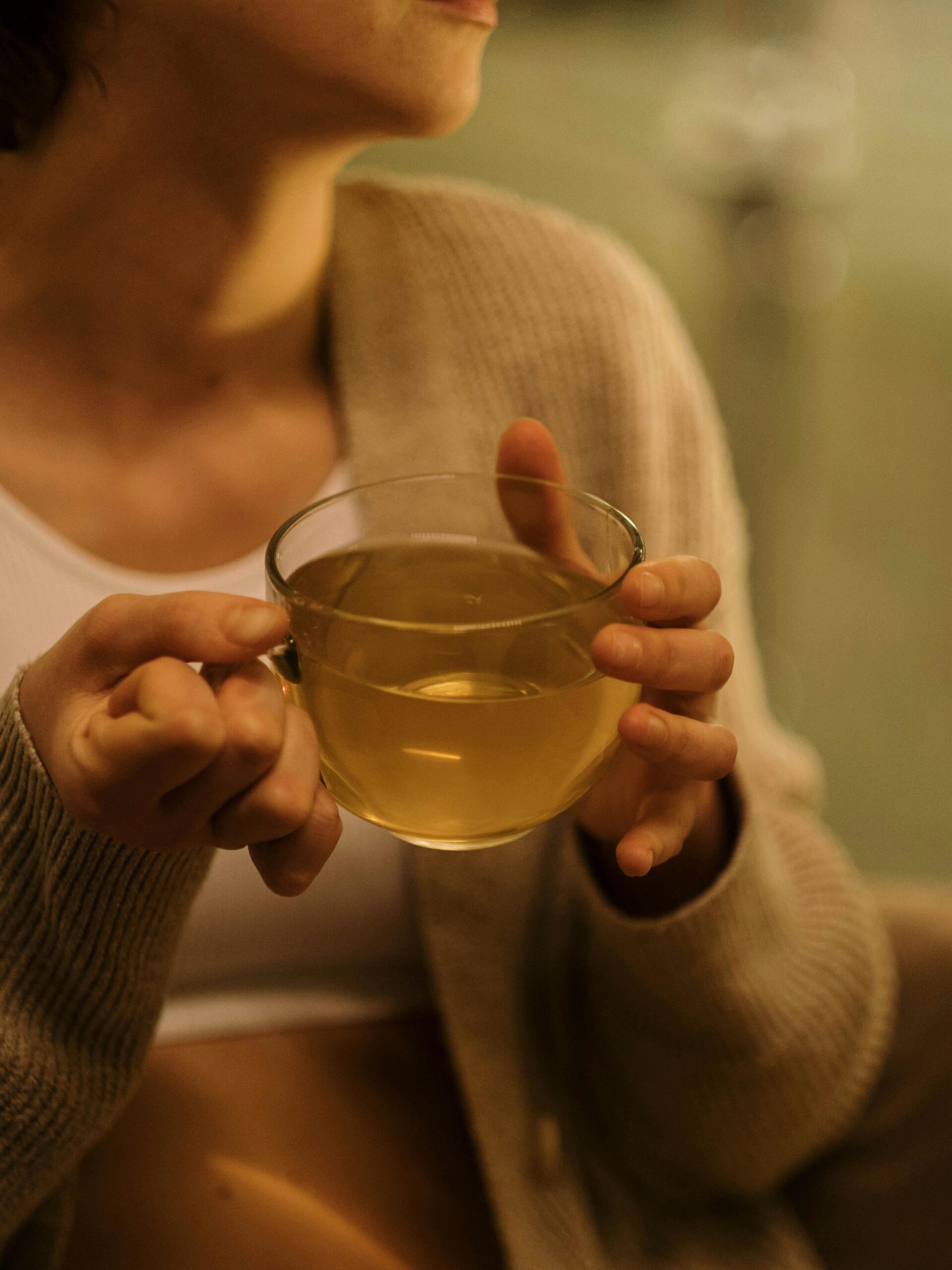
Tea tasting requires practice and attention to detail. Your palate can grow more sensitive with regular training and focused tasting sessions.
- Start with basic taste categories like sweet, bitter, and floral notes in your tea. These form the foundation of your tasting vocabulary and help you identify key flavor components.
- Keep a tea journal to track your observations about each tea you sample. Document the appearance, aroma, taste, and aftertaste to build a personal reference library.
- Compare similar teas side by side to spot subtle differences between varieties. This direct comparison highlights unique characteristics that might go unnoticed when tasting teas separately.
- Use fresh, filtered water at appropriate temperatures for each tea type. Water quality significantly affects flavor extraction – soft water generally works better than hard water for most teas.
- Pay attention to mouthfeel and texture as you sip. Notice if the tea feels smooth, astringent, thick, or light on your tongue.
- Taste teas at different steeping times to understand how flavor develops. Short steeps might reveal delicate notes while longer ones bring out deeper flavors.
- Try cupping multiple infusions of the same leaves to experience how flavors change. Premium teas often reveal different character traits across several steepings.
- Smell the empty cup after drinking to catch lingering aromas. These final notes can provide important clues about the tea’s quality and processing.
- Taste without distractions in a neutral environment free from competing smells. Your focus matters for detecting subtle flavor nuances.
- Sample teas from various regions to understand how terroir affects taste. Elevation, soil, and climate create distinctive flavor profiles in teas from different areas.
- Practice describing flavors using specific terms rather than vague descriptions. Precise language helps train your brain to recognize those characteristics again.
- Cleanse your palate between tastings with plain water or mild crackers. This reset allows you to approach each new tea without flavor interference.
Quality Markers and Evaluation
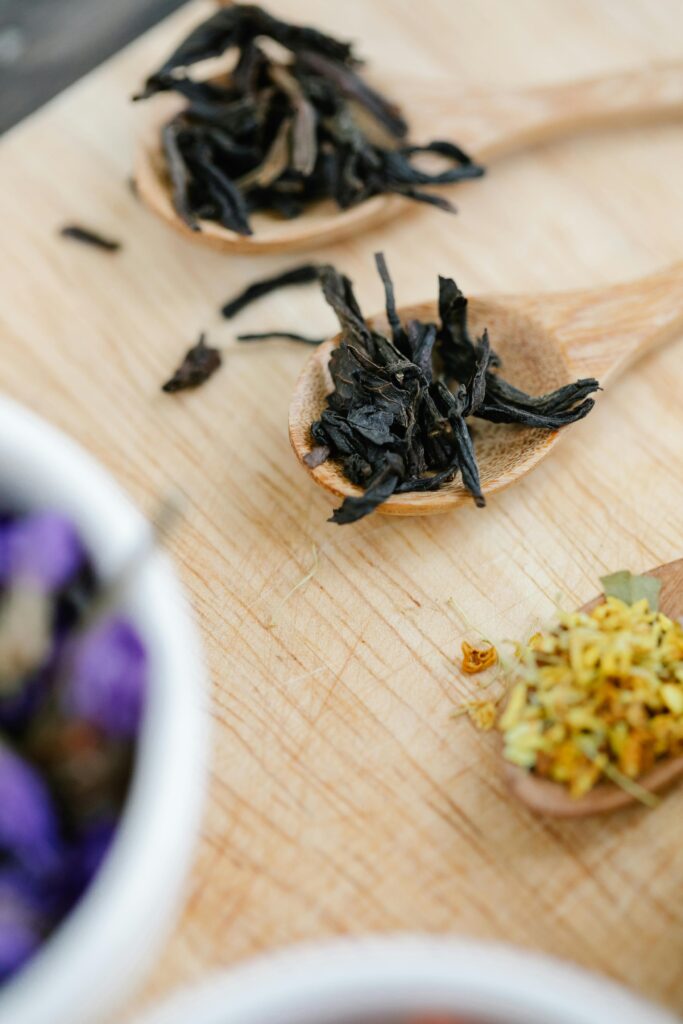
Top-tier rare teas reveal their quality through visual cues that experts check first. Fresh leaves display consistent color with a vibrant, healthy appearance that signals proper handling.
The shape, size, and texture of leaves tell stories about harvesting care and processing skill. Premium Da Hong Pao oolong, for instance, shows evenly twisted leaves with a deep amber-green hue, while authentic Silver Tips Imperial presents uniform silver-white buds with downy hair intact.
Flavor evaluation requires attention to multiple taste dimensions that unfold across infusions. Expert tasters assess the initial aroma, first-sip impact, body weight on the palate, and finish length.
High-quality Gyokuro delivers umami richness with sweet undertones, while properly aged Pu’er presents complex woody notes without mustiness. The best rare teas maintain their flavor profile through several steepings, with each round revealing new taste elements rather than simply fading.
This staying power marks true craftsmanship in tea production and serves as a key indicator of authenticity in the most sought-after varieties.
Temperature and Water Quality
Water quality forms the foundation of every great cup of rare tea. Pure water without chlorine or mineral excesses lets the tea’s subtle notes shine through. Each tea type demands specific temperatures for optimal flavor release.
Green teas need cooler water (75-85°C) to prevent bitterness, while black teas require near-boiling water (95-100°C) to extract their full character.
Most rare teas need brewing temperatures below 212°F to protect their delicate flavors. Brewing time matters just as much – green teas need only 2-3 minutes, while black teas develop best with 3-5 minutes of steeping.
Tea masters often use special kettles with temperature control to achieve this precision. The right water temperature brings out the careful craftsmanship that makes these rare teas so sought after by collectors and enthusiasts worldwide.
Special Equipment Needs
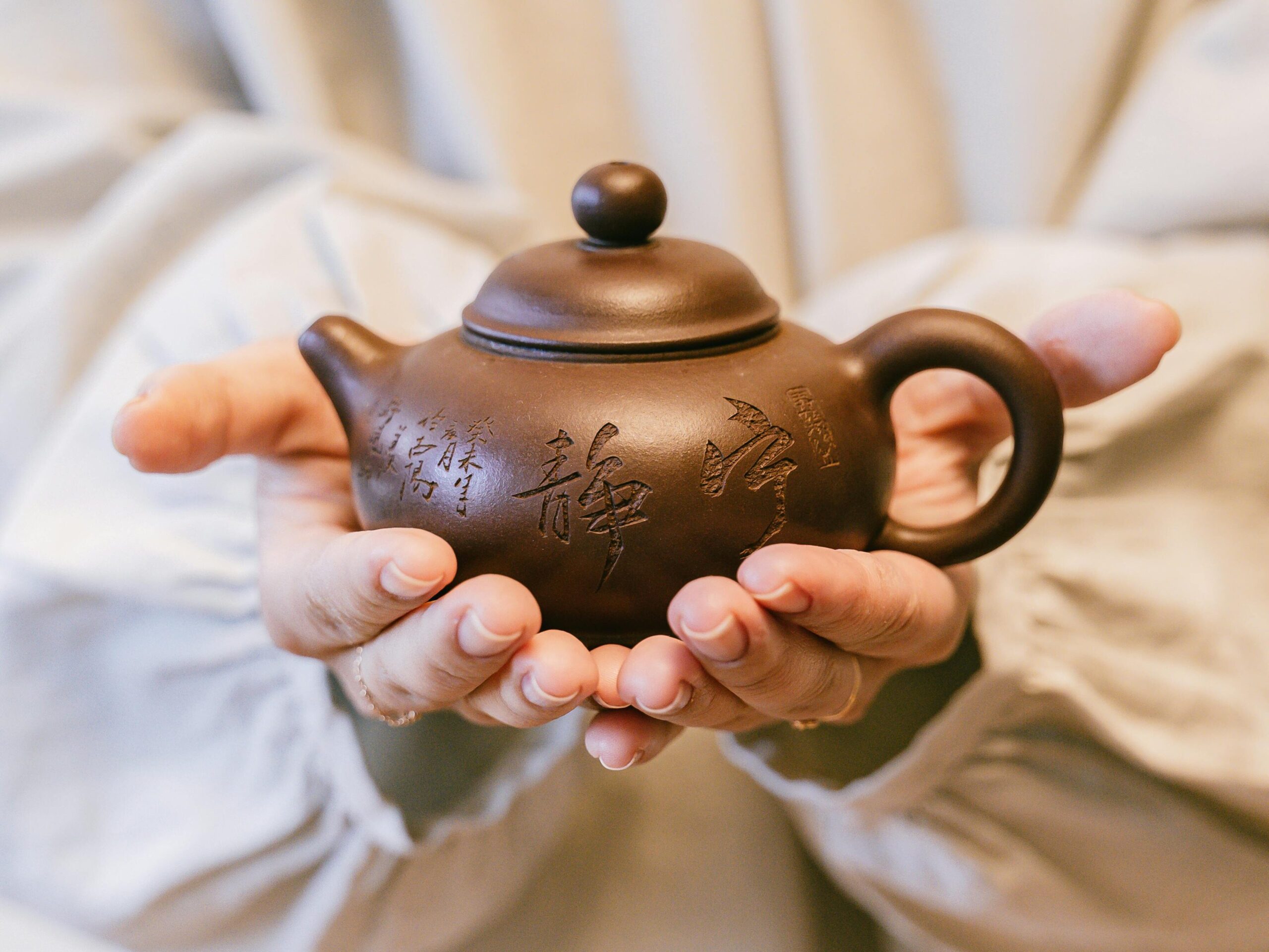
Rare teas demand proper tools to unlock their full potential. Teapots made from specific materials like Yixing clay or glass serve different tea types – clay absorbs flavors while glass showcases visual brewing.
A gaiwan, the lidded Chinese bowl, offers precise control for multiple infusions of premium teas like Da Hong Pao or Silver Tips Imperial. Quality infusers with fine mesh prevent leaf fragments from escaping while allowing full expansion of whole leaves.
Tea scales measure leaves with gram precision, ensuring consistent brewing results with high-demand rarities. Water temperature gauges help you hit exact heat points – crucial since delicate yellow teas need cooler water than Pu’er varieties.
These tools aren’t just fancy extras; they form the foundation of careful tea preparation. Each piece of equipment delivers a more authentic experience, letting you taste the true character of teas grown at high elevations or processed through traditional methods.
Multiple Infusion Techniques

Beyond proper teaware, mastering multiple infusion techniques unlocks the full value of rare teas. Many premium teas reveal different flavor profiles across several steepings, with each pour offering new dimensions to explore.
- Gongfu method requires short steeps starting at 10 seconds and gradually increasing by 5-10 seconds with each pour. This Chinese approach works best for oolongs and pu-erh teas.
- Western-style infusion uses longer steep times of 2-3 minutes with larger amounts of water. This method suits black teas and some green varieties for daily drinking.
- Cold brewing involves steeping tea in room temperature water for 6-8 hours in the refrigerator. This gentle process draws out sweet notes while reducing bitterness in many tea types.
- Flash brewing starts with a quick 5-second rinse followed by very brief steeps. This technique helps access the subtle flavors in high-mountain Taiwanese oolongs.
- Grandpa style means adding hot water directly to leaves in a tall glass and drinking as the tea steeps. Tea drinkers add more water as the cup empties, creating an evolving taste experience.
- Japanese step-down method begins with the hottest water for the first steep, then uses cooler water for each following infusion. This works well with delicate green teas like gyokuro.
- Da Hong Pao oolong can yield 4-6 distinct infusions using the proper technique. Each steep reveals different flavor notes from woody to sweet.
- Temperature adjustment between steepings helps extract different compounds. Lower the water heat by 5-10°F with each new infusion for white and green teas.
- Timing progression follows a pattern for most teas: start short, then gradually increase steep time as flavors diminish. The second steep often delivers the richest taste profile.
Tea-Specific Brewing Guidelines
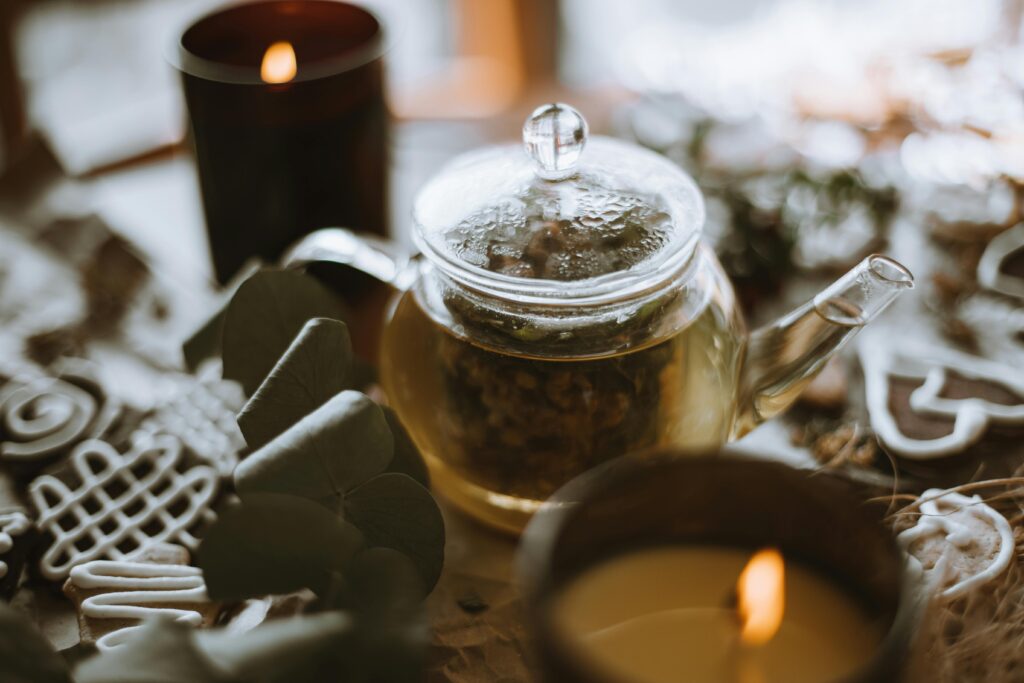
Different teas need specific brewing methods to reveal their full flavor potential. Each rare tea variety has unique requirements for water temperature, steeping time, and equipment that can make or break your tasting experience.
- Da Hong Pao performs well with water at 195-205°F (90-96°C), using short initial steeps that gradually increase in length.
- Silver needle white tea shines at lower temperatures around 175°F with a longer 3-minute steep to coax out its delicate sweetness and subtle melon notes.
- Japanese gyokuro demands cooler water at 140-150°F and should steep for 2 minutes to highlight its unique umami character from shading techniques.
- Taiwanese high mountain oolongs perform best at 185°F with short 45-second steeps that can be repeated up to 7 times as the leaves unfurl.
- Aged pu-erh teas need a quick 10-second rinse before brewing at 205°F for 30 seconds, with steep times increasing slightly for later infusions.
- Yellow teas require gentle handling with 175°F water and a 2-minute steep to preserve their rare mellow sweetness and smooth body.
- First-flush Darjeeling should never see boiling water – steep at 185°F for 3 minutes to capture its muscatel grape notes.
- Milk oolong benefits from a gaiwan vessel with 190°F water and 45-second steeps to highlight its natural creamy texture without drowning its floral notes.
- Matcha must be sifted and whisked with water at 175°F using a bamboo chasen to create the proper froth and prevent clumping.
- Jun Shan Yin Zhen (Silver Needle) from China needs a glass vessel to appreciate its visual beauty while steeping at 170°F for 2-3 minutes.
- Himalayan Silver Tips Imperial requires 180°F water with a 2.5-minute steep in spring water to showcase its rare honey-orchid aroma.
- Vintage Narcissus oolong should be brewed gongfu style with 195°F water, starting with a 10-second steep and adding 5 seconds for each subsequent infusion.
Mastering these brewing guidelines forms just one aspect of tea appreciation – next we’ll explore the cultural significance that elevates these rare teas beyond mere beverages.
Assessing Authenticity
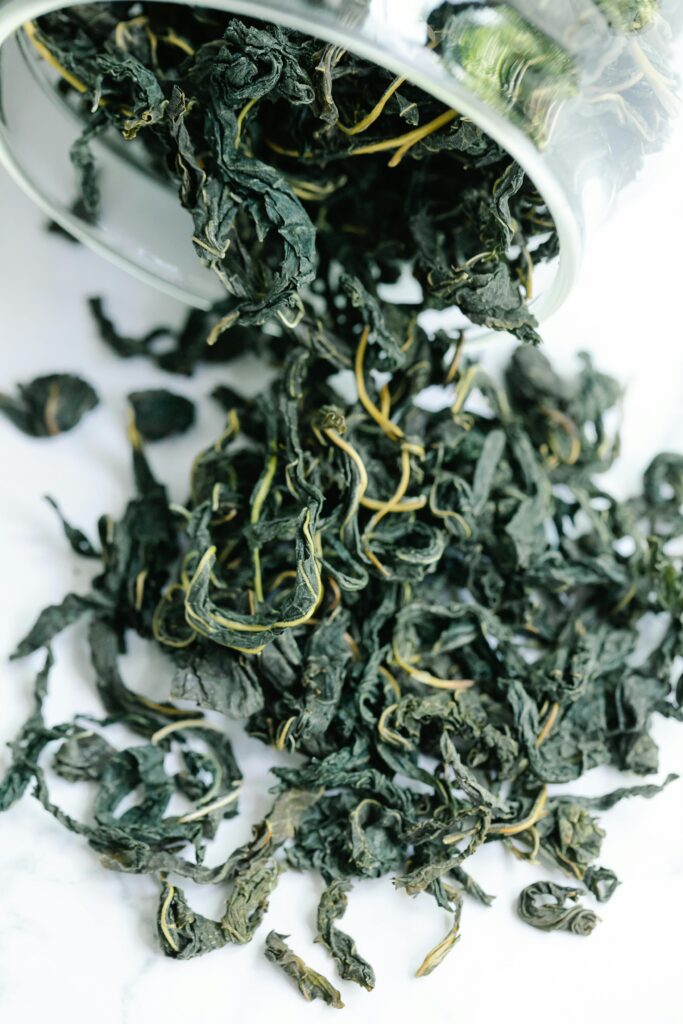
Genuine rare teas often face imitation in today’s market. Tea experts look for specific leaf appearance, aroma profiles, and taste characteristics that match the tea’s origin claims.
The color should match known standards—Da Hong Pao shows distinct reddish hues while authentic Silver Tips display silvery down.
High-quality rare teas typically maintain their character through multiple infusions, often revealing different aspects with each steep.
Price alone doesn’t guarantee authenticity; even high-priced teas require verification through trusted sources or certification documents that trace the tea’s journey from specific gardens to your cup.
Cultural Significance
Tea ceremonies across cultures show how rare teas connect to royal traditions and social status. These special drinks have shaped trade routes and diplomatic gifts for centuries, creating deep bonds between nations through the simple act of sharing tea.
Imperial Tea Traditions
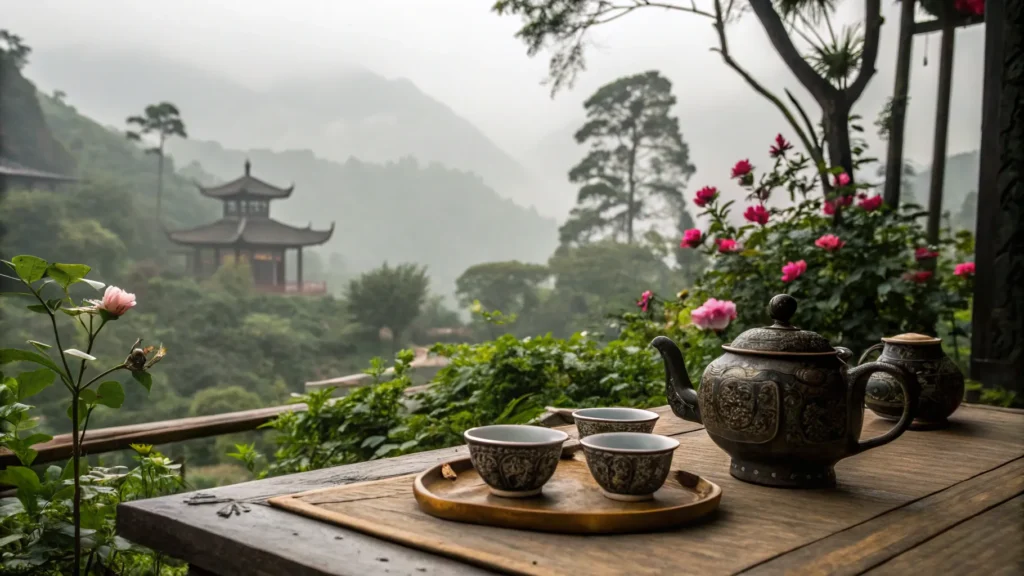
Imperial tea traditions date back to ancient China, where tea became a symbol of status and refinement. According to Chinese legend, Emperor Shen Nong discovered tea around 2737 BCE, beginning its journey from medicine to royal beverage.
The imperial courts developed strict rules for tea preparation, serving, and appreciation that spread throughout the empire. High-quality teas like Da Hong Pao were often reserved exclusively for emperors and their closest advisors.
Lu Yu’s “Cha Ching” text established formal tea rituals that shaped how royalty enjoyed rare teas for centuries. These traditions spread to Japan, where Sen Rikyu codified the Japanese Tea Ceremony in the mid-1500s during the Empire of Japan period.
The ceremony transformed simple tea drinking into an art form that balanced spiritual practice with social etiquette. The careful attention to detail in these imperial traditions still influences how connoisseurs prepare the rarest teas today.
Each imperial tradition valued specific brewing methods, water temperatures, and serving vessels that best showcased the unique flavors of premium teas. The Japanese preferred shaded Gyokuro served in small portions, while Chinese emperors often enjoyed oolong varieties with multiple infusions to experience every subtle flavor note.
These ancient practices now guide modern collectors on proper storage requirements for preserving their most precious tea treasures.
Tea Competition Standards
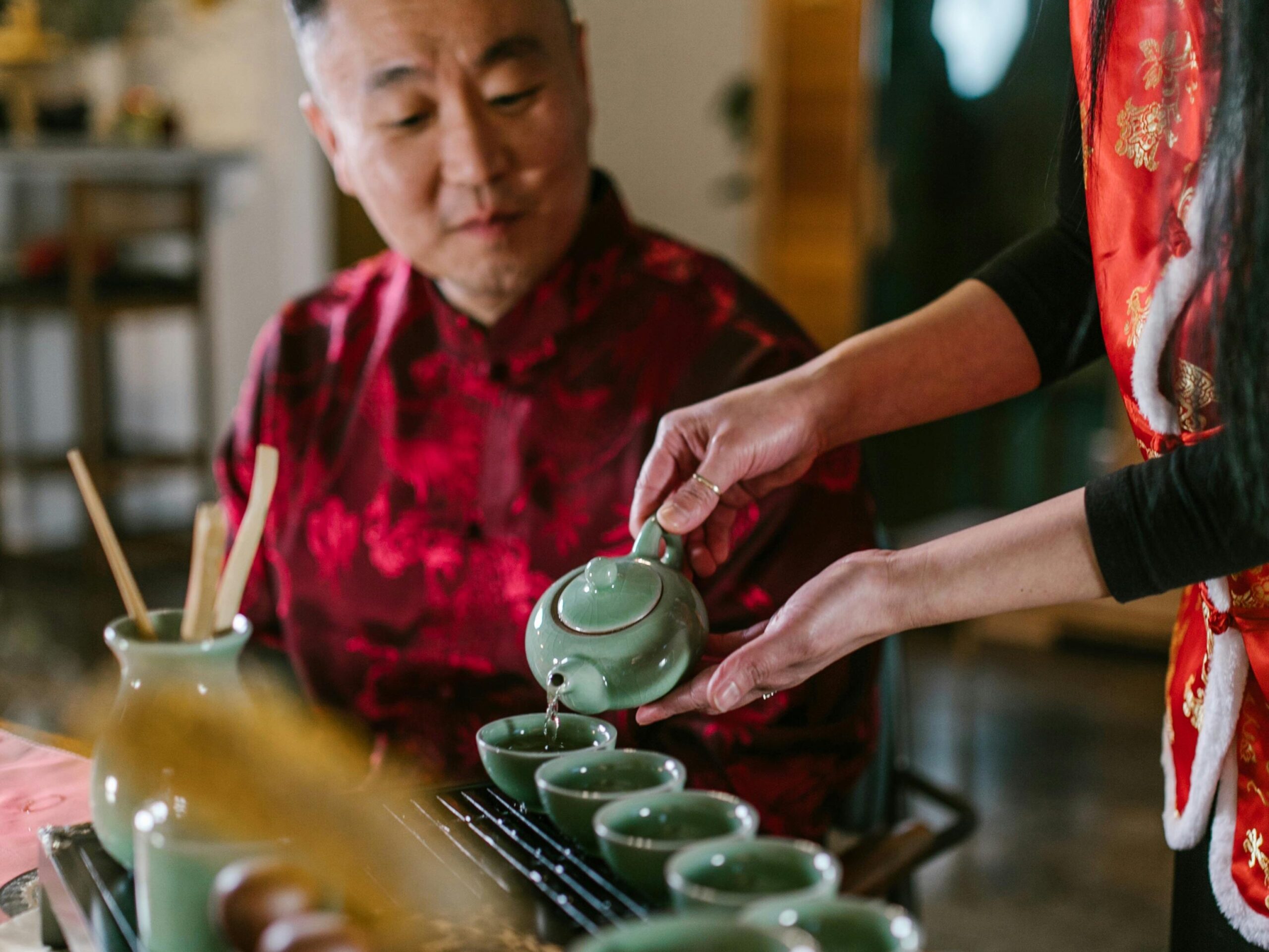
Tea competitions set strict rules for judging the world’s finest leaves. Judges score each tea on five main points: leaf appearance, aroma, liquor color, taste, and aftertaste. These events happen yearly in major tea regions like Taiwan’s Dong Ding Oolong contest and China’s National Tea Championship.
Expert tasters train for years to detect subtle flavor notes that separate good teas from great ones.
Quality markers vary by tea type but always focus on cultivation and processing excellence. For example, high-grade Gyokuro must show deep umami flavor from proper shading techniques.
Pu’er tea entries face scrutiny for aging potential and current taste profile. Many competitions use blind tasting methods where samples receive only numbers to prevent bias. Competition winners typically command premium prices due to their recognized quality.
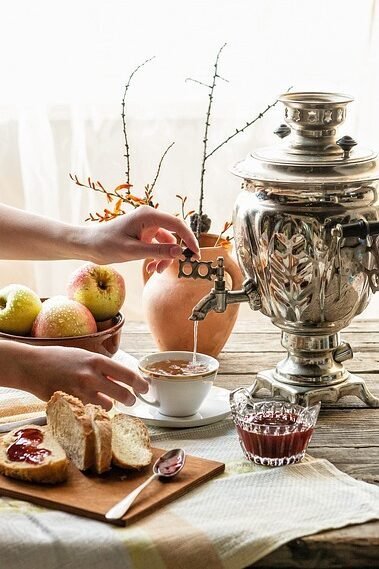
Regional Tea Ceremonies
Tea ceremonies across the globe showcase unique cultural values through distinct rituals. Japanese tea ceremonies focus on mindfulness and respect, using specialized tools to prepare matcha in a precise sequence.
Chinese gongfu cha celebrates the tea’s flavor through multiple short steepings, while British afternoon tea emphasizes social connection over scones and finger sandwiches.
Moroccan mint tea serves as a symbol of hospitality, poured from height to create foam. Russian samovars stand at the center of their tea tradition, with sweetened black tea sipped through sugar cubes.
Tibetan butter tea blends strong black tea with yak butter and salt, providing energy for high-altitude living. Each ceremony reflects local customs that have evolved over centuries.
Modern Appreciation
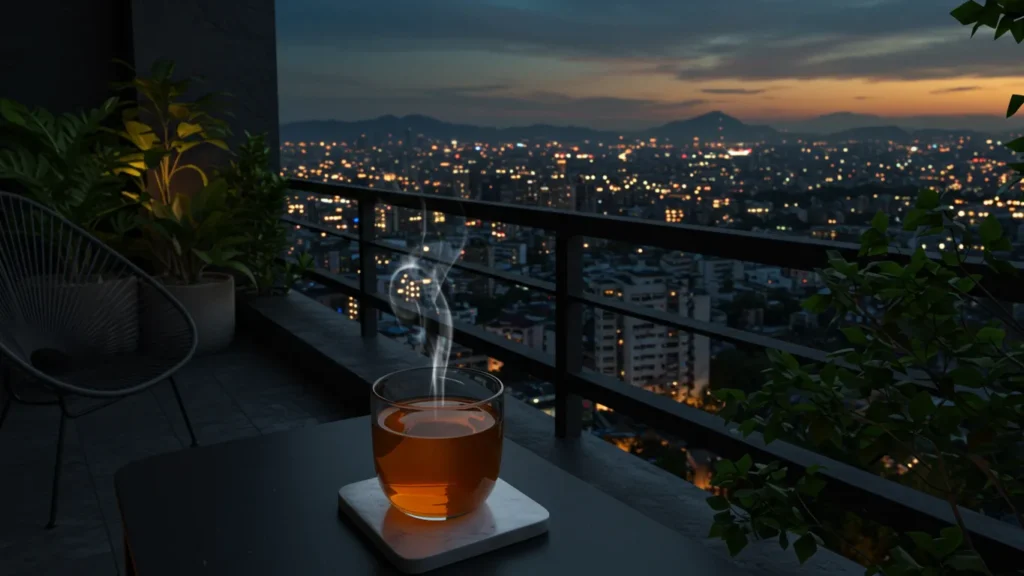
Modern tea appreciation includes online communities, specialty retailers, and organized tasting events. Instagram feeds showcase gongfu brewing sessions while online forums connect enthusiasts across continents.
Many people now collect prized varieties like Da Hong Pao or Silver Tips Imperial with the same passion once reserved for fine wines. This shift reflects growing interest in authentic sensory experiences rather than mass-produced options.
Digital platforms have transformed how we learn about tea culture, with virtual tastings and expert-led webinars making knowledge more accessible. Tea subscription services deliver small-batch treasures straight to homes, allowing drinkers to sample high-demand varieties without traveling to source regions.
The modern tea enthusiast values both tradition and innovation, appreciating careful craftsmanship while exploring new brewing methods that highlight each tea’s unique character.
Historical Tea Legends
Tea legends add magic to our favorite brews. Da Hong Pao, or “Big Red Robe,” tells of a Ming Dynasty emperor who draped his royal robe over tea bushes that cured his mother’s illness.
These bushes still grow on Wuyi Mountain, producing tea so rare that the last harvest from the original plants sold for over $10,000 per ounce. The story enhances both the cultural value and market price of this sought-after oolong.
Tie Guan Yin, the “Iron Goddess of Mercy,” carries its own fascinating tale. A poor farmer named Wei found a neglected temple to Guanyin and cleaned it daily despite his poverty. In a dream, the goddess led him to a tea plant which he cultivated with care.
His tea became famous for its unique orchid aroma and brought prosperity to his village. Today, this oolong remains highly prized for its complex flavor and the careful skill needed to process it properly.
These stories connect tea to imperial courts, divine intervention, and ancient wisdom. The legends transform simple leaves into cultural treasures that tea scholars study alongside brewing methods.
After this, we’ll explore how proper storage affects these precious teas and how collectors preserve their quality for years.
Preservation and Collection
Rare teas need proper care to keep their magic alive for years. Learn the best ways to store your prized leaves and build a tea collection that grows in both value and taste with time.
Storage Requirements
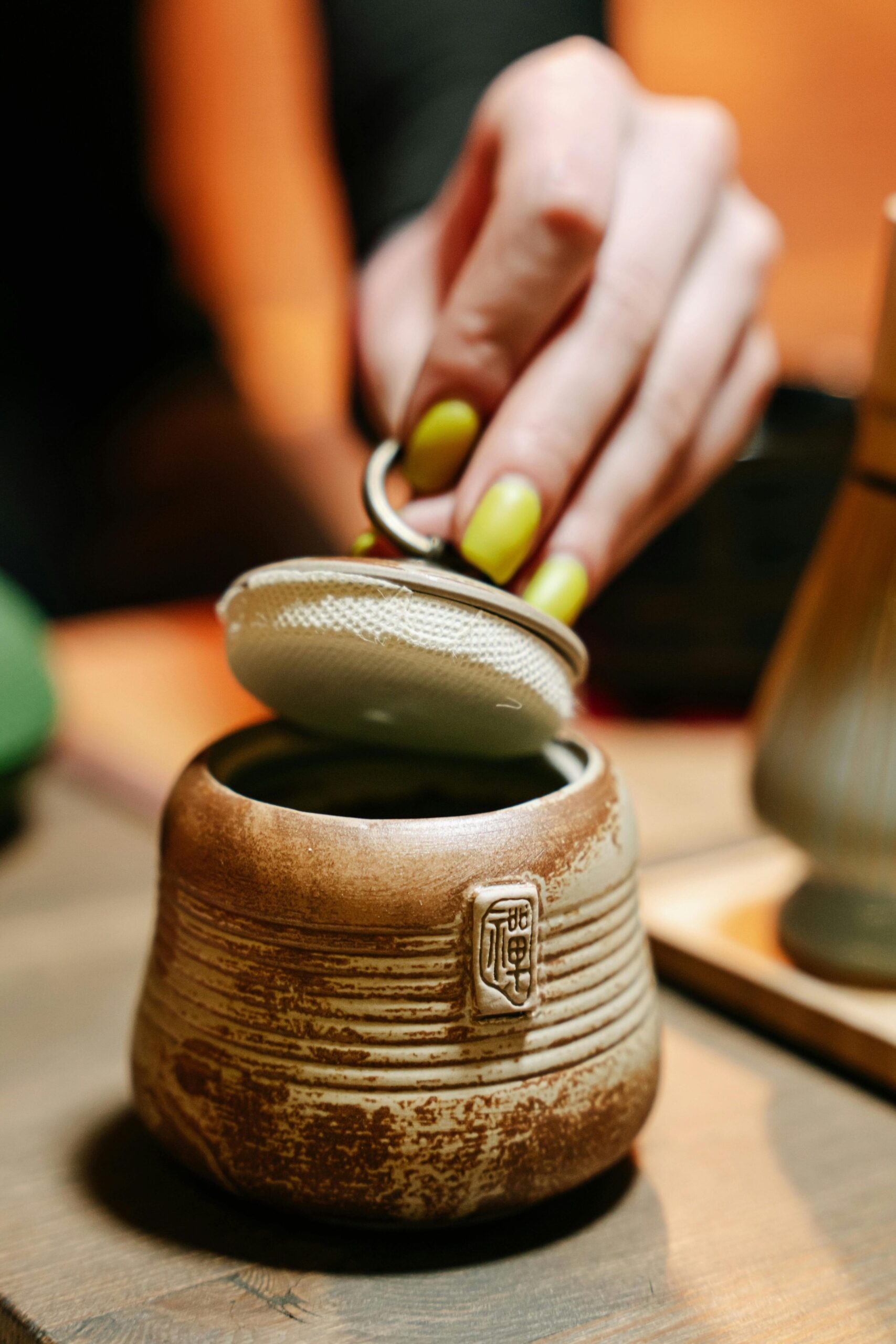
Proper storage makes all the difference between a tea that maintains its rich flavors and one that becomes flat and lifeless. Your rare tea collection needs specific conditions to preserve its quality and investment value.
- Use airtight containers made of ceramic, glass, or tin to block moisture and outside odors from affecting your tea leaves.
- Keep tea away from direct sunlight as UV rays break down the compounds that give tea its flavor and health benefits.
- Store your collection in cool, dry places with stable temperatures between 60-70°F (15-21°C) to slow oxidation processes.
- Avoid areas with strong smells like kitchens or spice cabinets since tea leaves easily absorb nearby odors.
- Separate different tea types in individual containers to prevent flavor mixing between delicate whites and stronger black teas.
- Check for signs of stale tea regularly, including dull aroma, faded color, and poor texture in the brewed cup.
- Label each container with purchase date and type to track aging and freshness of your collection.
- Consider humidity control packets for high-value teas if you live in areas with changing seasonal humidity.
- Maintain distance between tea storage and appliances that generate heat or moisture like dishwashers or coffee makers.
- Freeze very rare or expensive teas only as a last resort, as the thawing process can introduce damaging moisture.
Building a Collection
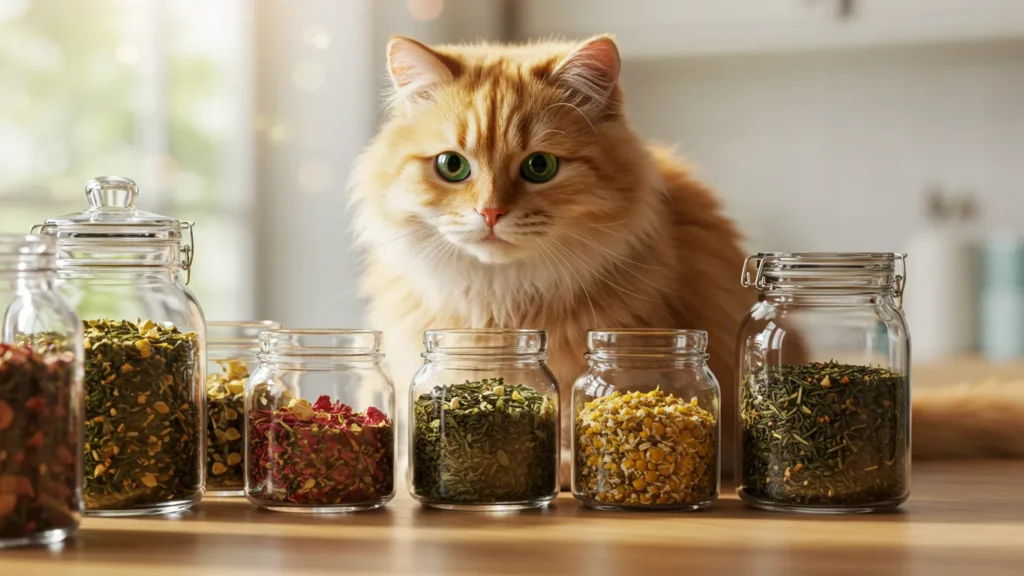
Rare teas deserve special care and thoughtful collection practices. Creating a personal tea library allows you to explore flavors across seasons and years while preserving these botanical treasures.
- Start with variety rather than quantity by selecting one premium tea from each major category (white, green, oolong, black, and puerh).
- Purchase in small amounts (30-50 grams) to maintain freshness and rotate stock regularly.
- Document each tea with purchase date, origin details, and tasting notes in a dedicated journal or digital app.
- Invest in proper storage containers made of ceramic, glass, or tin that block light and seal tightly against moisture and odors.
- Create a storage system away from heat, light, strong smells, and humidity—ideally in a cool, dark cabinet dedicated to your collection.
- Sample teas before buying larger amounts, especially for high-priced varieties like Da Hong Pao or Silver Tips Imperial.
- Connect with reputable vendors who provide detailed information about harvest dates, processing methods, and growing regions.
- Focus on seasonal acquisitions, as spring harvests often yield the most prized flavors for many tea types.
- Balance your collection between everyday drinking teas and special occasion rare finds that might be enjoyed less frequently.
- Learn the optimal aging potential for different tea types—white and puerh teas often improve with age while green teas typically don’t.
- Consider regional representation by curating teas from diverse growing areas like Taiwan’s high mountains or Japan’s shaded gardens.
- Develop relationships with tea suppliers who can alert you when limited batches of premium teas become available.
Authentication methods play a crucial role in ensuring your collection contains genuine rare teas rather than imitations.
Seasonal Considerations
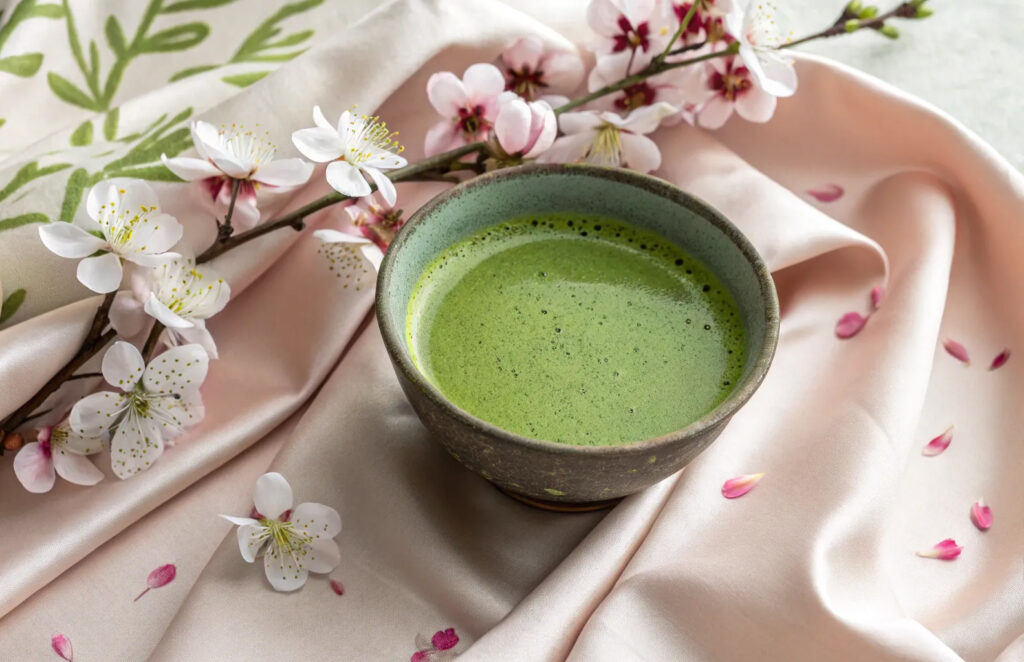
Tea harvests follow strict seasonal patterns that directly impact flavor quality. Early spring pickings yield the most prized leaves, especially for white teas like Baihao Yinzhen (Silver Needle).
These first flush teas contain higher concentrations of amino acids and less tannin, creating sweeter, more delicate cups. High-elevation tea farms often have shorter harvest seasons, particularly for spring teas, which naturally limits production.
Serious collectors track harvest dates with the same attention wine enthusiasts give to vintage years. Spring 2019 Darjeeling differs markedly from its 2020 counterpart due to rainfall patterns and temperature variations.
Tea gardens in Japan often cover their bushes before harvest, controlling light exposure to boost chlorophyll and L-theanine levels in their premium Gyokuro. This careful timing creates distinct flavor profiles that cannot be replicated in other seasons, making certain harvests highly sought after in tea circles.
Authentication Methods
Authentication of rare teas requires specific methods to protect buyers from counterfeit products. Tea experts use several proven techniques to verify the authenticity of premium varieties.
- Visual inspection checks for proper leaf size, shape, and color patterns unique to each tea variety.
- Aroma assessment identifies distinct scent profiles that counterfeit teas cannot replicate.
- Chemical composition testing measures levels of catechins, theanine, and caffeine to verify tea types.
- Origin certification documents trace the tea to specific farms or growing regions.
- Microscopic examination reveals cellular structures that differ between genuine and fake teas.
- Taste evaluation by certified tea masters confirms flavor profiles match known standards.
- DNA testing identifies the exact tea plant variety and can detect adulterants.
- Infrared spectroscopy creates a unique “fingerprint” of the chemical makeup of authentic teas.
- Package verification checks for proper seals, stamps, and markings from official tea boards.
- Price comparison helps spot deals that seem too good to be true for rare varieties in high demand.
- Harvest dating verification confirms the tea was collected during the correct season.
- Water test observation of how leaves unfurl during brewing reveals processing quality.
Conclusion
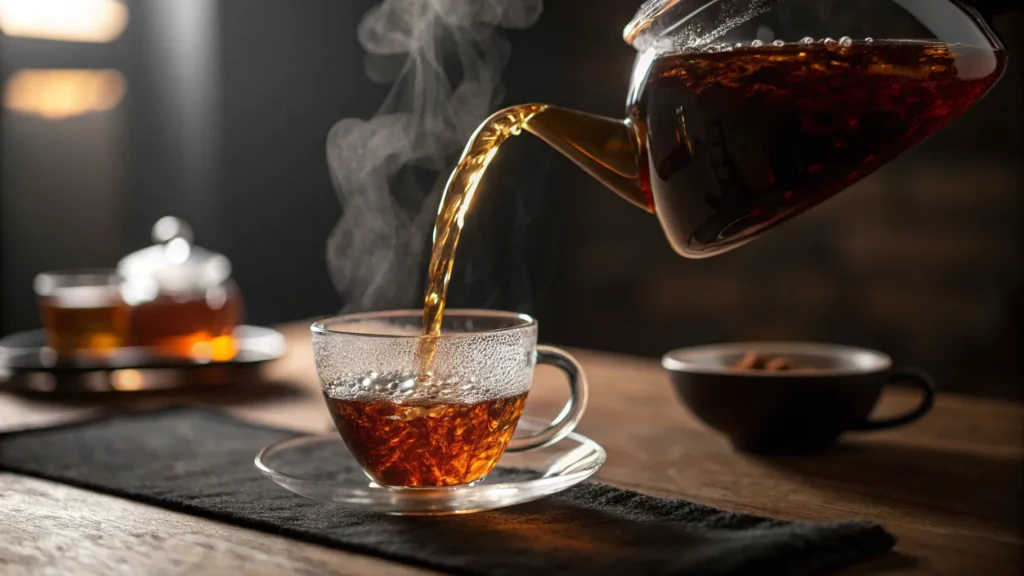
Rare teas offer a gateway to centuries of craft and culture that few other drinks can match. Each sip connects you to ancient traditions, skilled artisans, and special places around the world.
Exploring rare teas offers access to complex flavors and centuries of tradition. Beginning with quality samples, proper storage, and appropriate brewing tools provides a solid foundation for appreciation.
Each tea offers unique characteristics worth discovering through careful preparation and tasting.
FAQs
1. What makes certain types of tea considered “rare” or “exquisite”?
Rare teas earn their status through limited growing regions, specific harvesting methods, and distinctive flavor profiles. These range from traditional Chinese and Japanese varieties to unique regional specialties. Their scarcity and exceptional quality set them apart from everyday options.
2. Can you find rare teas locally or must they be imported?
Specialty tea shops in major cities offer some rare selections, while certain varieties may require sourcing from importers or directly from origin.
3. What equipment do I need to properly brew exotic teas?
A quality tea pot, precise temperature control, and filtered water form your essential toolkit. For specialized brews like Masala chai, a sturdy pot and blender help incorporate spices properly. Simple equipment used correctly makes all the difference.
References
- https://iteaworld.com/blogs/guide?srsltid=AfmBOorIdm_jWG9uiSwfXZ2lL3F8Ma0h4sNhIsdiXd68g9bRaaqq1rU1
- https://pressbooks.cuny.edu/chinesefarmerteas/chapter/yunnan-tea-price-factors-types-and-how-to-choose-the-best-value/
- https://www.teadrunk.com/blogs/educational-articles/terroir-and-tea-1?srsltid=AfmBOopIqdtZzbbcuZ7UXcuHfybCdfsFGpj1eH6IS5QcGxowiUeouszH (2022-03-14)
- https://teajtea.com/blogs/learning-tea/unveiling-the-exquisite-elixir-discovering-the-rarest-tea-in-the-world?srsltid=AfmBOoots04dVyrPqmTnY1fD_d_zEkhywSz5bL5M2pA8DQOWQojEcKJo
- https://pmc.ncbi.nlm.nih.gov/articles/PMC11521711/
- https://orientaleaf.com/blogs/tea-101/da-hong-pao-the-king-of-oolong-teas?srsltid=AfmBOorRosBX0QUuBWA-LV00uPGj0BKAtKTWR2MUs1upbzne6vTXfps2
- https://www.paperandtea.com/blogs/journal/the-world-of-gyokuro
- https://www.teafromtaiwan.com/loose-oolong-tea/da-yu-ling?srsltid=AfmBOoqsg6cAMhXr3XRmc1o5SubY61YDl7abRAOAhtf-QpUImaQd2swA
- https://danfetea.com/blogs/tea-blog/discover-silver-tips-white-teas?srsltid=AfmBOorWqMNSAdr9hyG3Jv5FKCSoX0IWRHe5Rl4gqj7DFXxfZHAXD0FV (2022-07-26)
- https://teajtea.com/blogs/learning-tea/unveiling-the-exquisite-elixir-discovering-the-rarest-tea-in-the-world?srsltid=AfmBOoq2uqUejm_UvYqt8zIr5jOkr-2K1x7PbIvworpTkdC4aQ9-L-lx
- https://pathofcha.com/blogs/all-about-tea/how-elevation-affects-tea-quality?srsltid=AfmBOopjKcy8-vZgbm2cPwUa3k2LdTiHiozUsZ8rtfcNK1ecr_QZG5-b
- https://senchateabar.com/blogs/blog/da-hong-pao?srsltid=AfmBOopuumC3889rt8qumj1lgZtwZtY3giwkT4WnYmLJAbwUuubPvlmO
- https://pathofcha.com/blogs/all-about-tea/yellow-tea-a-rare-tea-to-discover-part-1?srsltid=AfmBOoqwFPw-5tZavIr-mzmeCK4PlYylNoREg2OmHC93rh5_LsvOfjas
- https://www.mastersteas.com/teas/jun-shan-yin-zhen.html?srsltid=AfmBOooollMWdvwa1LHEMCiKBjlD8tr7niH6CdS-kIuuhr7Oe4WCRSzk
- https://rareteacellar.com/products/emperors-gyokuro
- https://teajtea.com/blogs/learning-tea/unveiling-the-exquisite-elixir-discovering-the-rarest-tea-in-the-world?srsltid=AfmBOoqvSMqj7hyEFF2giRDE94aqUgQYEvDNgHVJdzVGilBLgUuoMCpg
- https://grandteaimports.com/products/aged-narcissus-water-sprite-water-fairy-tea-%E9%99%B3%E5%B9%B4%E6%B0%B4%E4%BB%99?srsltid=AfmBOoqAiQUM8GyOyCqolrLFAXfftBk8NQ2g16x_tXCL2hT3V2_HCQT2
- https://themillsacramento.com/products/aged-white-peony
- https://rareteacompany.com/en-us/products/chinese-iron-goddess-oolong?srsltid=AfmBOopXdytrE1g7aj3IeGjO5Zj7wTVrEbW6kf7TErx-73fkkDuG4mqh
- https://camellia-sinensis.com/en/blog/how-to-properly-store-tea?srsltid=AfmBOorp0UxKV-tcBTS8dLlNFrQbnOcrHDg5tTBw9NoZwhVqm62fjVLx
- https://mansatea.com/blogs/learn/aged-tea?srsltid=AfmBOooeRqu_dlYRGGfFZ70CdcqeoeduqiA2nDNH_sQZcPT0uqkWggPu
- https://pickerspocket.com/blogs/news/title-the-art-of-hand-harvesting-tea-an-age-old-tradition-that-makes-a-difference?srsltid=AfmBOoqk1eB-Bh-BlvM-bk8z_LycZo49xerWfBfP3j3Nxc0913Y1d0Jk (2023-06-28)
- https://elischolar.library.yale.edu/cgi/viewcontent.cgi?article=1010&context=ceas_student_work
- https://iteaworld.com/blogs/guide/tagged/tea-knowledge?srsltid=AfmBOopy9mEB9p3uuKBDz0d7-Gfbvyx-Iy_o8DJJK0tsaXc0ZEouAptt
- https://www.researchgate.net/profile/Lei_Feng6/publication/248381547_Tea_and_cognitive_function_of_elderly_people_-_evidence_from_neurobiology_and_epidemiology/links/00b495215389f13544000000.pdf
- https://www.wildfoods.co/pages/tea-guide?srsltid=AfmBOopjfriKO_WG3eLjE70RW1q5xa9Dqion1oIY4W25Ym1N-xJa8gUk
- https://www.paperandtea.com/blogs/journal/our-guide-to-yellow-tea
- https://teajtea.com/blogs/learning-tea/unveiling-the-exquisite-elixir-discovering-the-rarest-tea-in-the-world?srsltid=AfmBOoqDCw8rmsoIrzhiWHKYHcNo7buHbUy-6XLivp–ps9aKVIjHWYI
- https://www.tealeaves.com/blogs/explore-our-teas/tea-connoisseurs-tasting-guide?srsltid=AfmBOoraWtqTldU1pvhjfEQsgACWsGw5HRkC3RF7dE9OlAdma4kh_mwM
- https://teajtea.com/blogs/learning-tea/unveiling-the-exquisite-elixir-discovering-the-rarest-tea-in-the-world?srsltid=AfmBOorwPb6kNIZTaDnPyEGKmgjqJa2e81sRkRM2FBp39fnDKXBttRvR
- https://artfultea.com/blogs/101/types-of-tea-a-comprehensive-guide?srsltid=AfmBOoo5wavOAAk9y699i8j0g7imb0qHduh_jmD744gy_WQDeEAubR9j
- https://littleprayertea.com/blogs/our-blog/tea-tasting-101-developing-your-palate-for-loose-leaf-teas?srsltid=AfmBOoqTN_P5rZec0ojLj9UmiNZ49u544gcQeTzARdOZ2seI6bahH_2A (2023-05-19)
- https://www.tealeaves.com/blogs/explore-our-teas/tea-connoisseurs-tasting-guide?srsltid=AfmBOopwppv8OkaQVPJpDNcCGjKctr6ZrpCmEObzslqy5zG5rxVWhBi3
- https://rishi-tea.com/blogs/journal/why-water-temperature-is-important-when-brewing-tea?srsltid=AfmBOorSXcXMK_mkmZda7UbnmvcGd7kmCgordKlx_tDTqX7TLEeBzFdt
- https://us.palaisdesthes.com/en_us/us-tea-sommelier-a-step-by-step-guide-l033.html?srsltid=AfmBOoqvB-r-wTrkannF6TR8KOVKXg6eKmdcownHjKApcjhGGbPkJXJJ
- https://pressbooks.cuny.edu/chinesefarmerteas/chapter/brewing-techniques-for-different-tea-types/
- https://jyyna.co.uk/tea-taste/
- https://www.researchgate.net/publication/285764315_Authenticity_evaluation_of_tea-based_products (2025-01-15)
- https://www.theteaspot.com/pages/tea-traditions
- https://www.researchgate.net/publication/284281995_Tea_and_China%27s_rise_tea_nationalism_and_culture_in_the_21st_century
- https://www.paperandtea.com/blogs/journal/tea-ceremonies
- https://vocal.media/feast/the-tea-lover-s-library-25-essential-books-for-tea-enthusiasts
- https://www.amazon.com/Connoisseurs-Guide-Tea-Discover-Exquisite/dp/1845431448
- https://teacultureoftheworld.com/blogs/all/beyond-the-ordinary-exploring-the-most-expensive-teas-in-the-world?srsltid=AfmBOoq5cTiR9NNz7PqHfOULhyLBw6Ux2t949HX1vJ2KxCivHHdg_c9h
- https://jyyna.co.uk/storing-loose-leaf-tea/
- https://ftp.d-marin.com/Book/signup-forms/o2D6/index-htm-files/World-Atlas-Of-Tea-From-The-Leaf-To-The-Cup-The-Worlds-Teas-Explored-And-Enjoyed.pdf
- https://www.goodreads.com/book/show/3620612-the-connoisseur-s-guide-to-tea
- https://www.researchgate.net/publication/286145547_Authenticity_of_Tea_C_sinensis_and_Tea_Products (2024-10-22)



